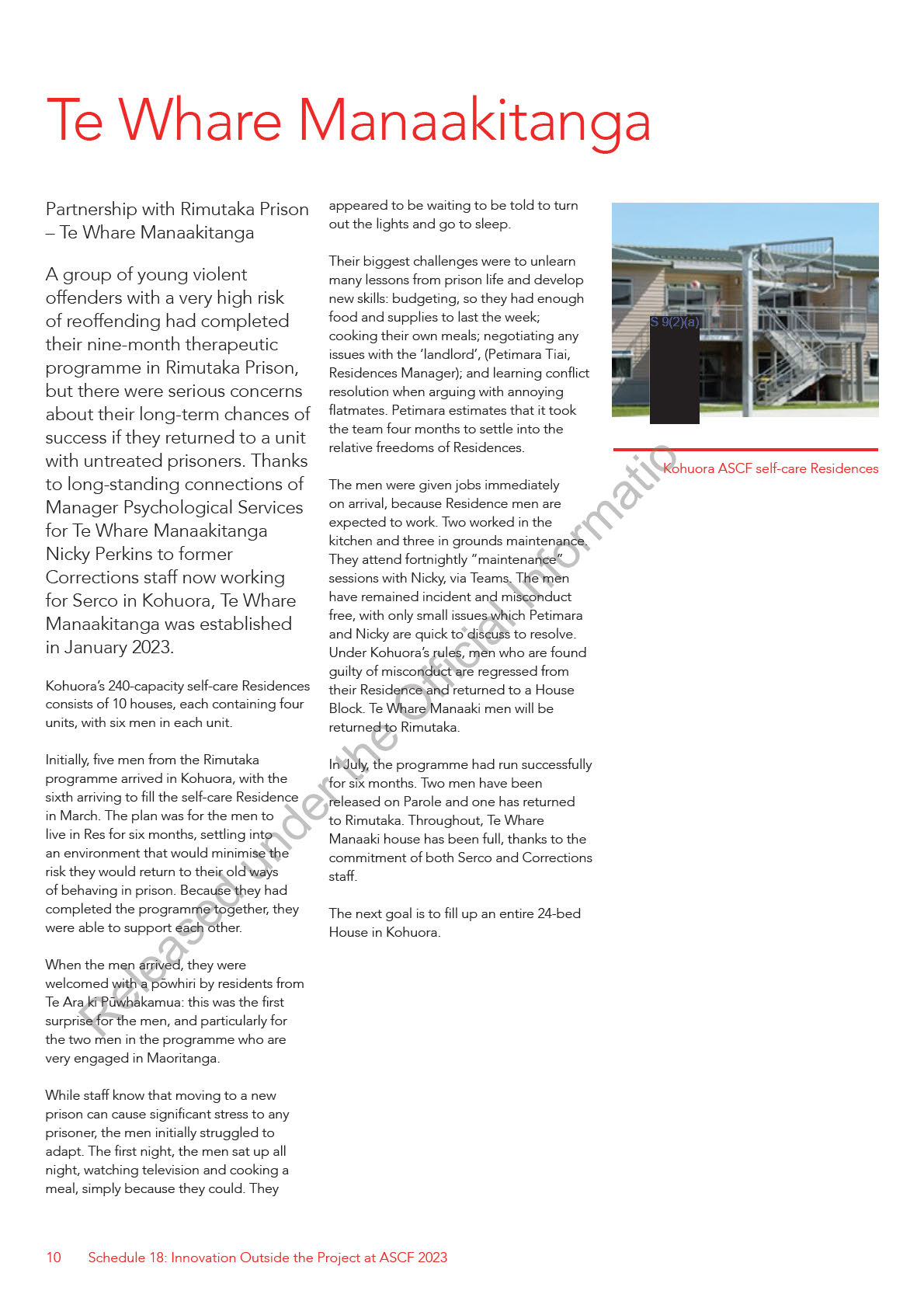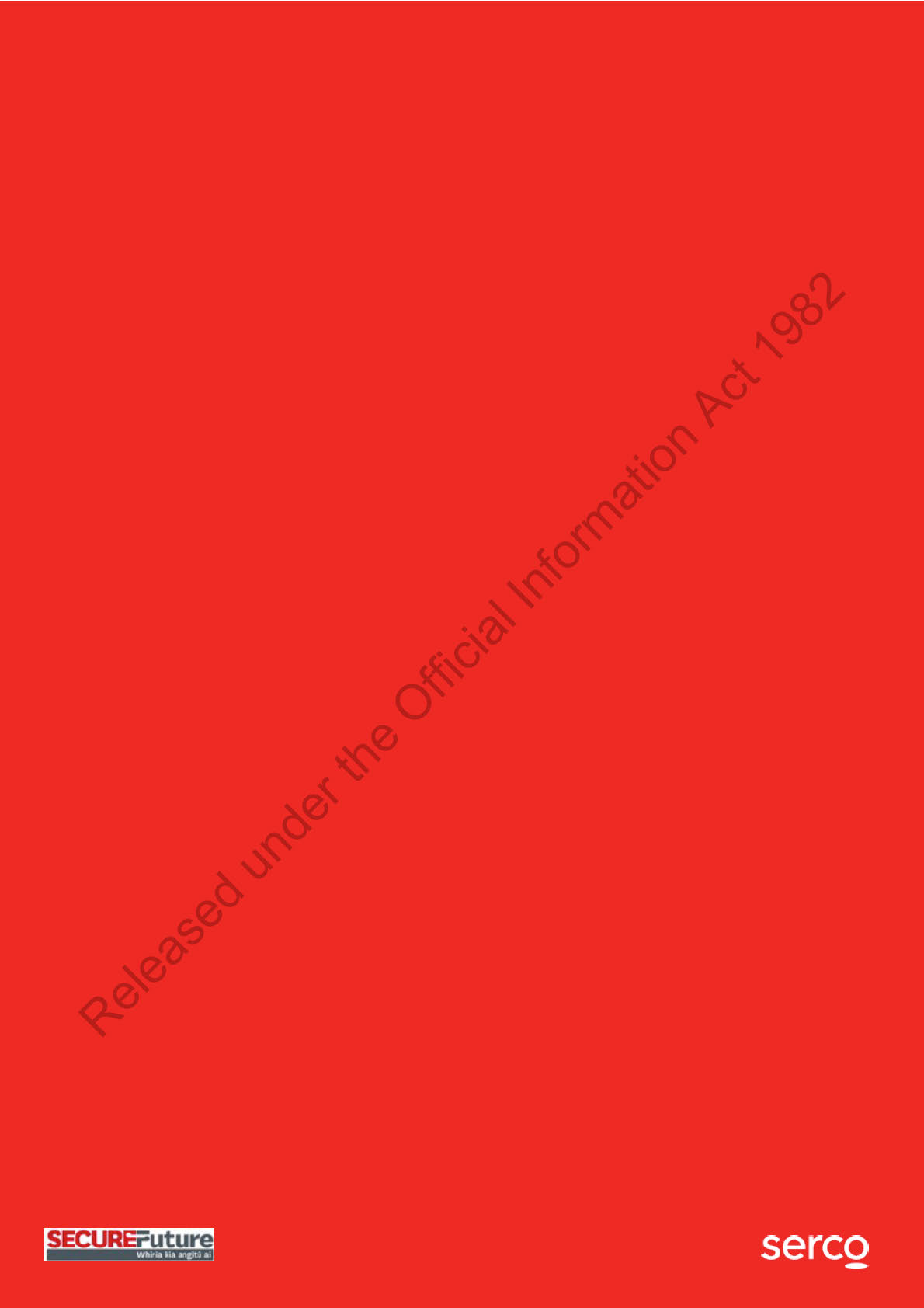
Contents
1.
Th
e Pūwhakamu
a Concep t
– Māor iRehabilitatio
n an
d Reintegration
4
2.
Take
2 Codin
g Programm
e
– Rehabilitatio
n an
d Reintegration
6
3.
Video Conference Suites – Whāna u Engagement
7
4.
Externa lWorke rDures
s Alar
m
– Staf fan
d Escort
s Safet
y Initiative
8
5.
Barbe rSho
p – Skil s Trai
ni
ng
Programme
9
6.
Appendix
10
under the Official Information Act 1982
Released
Schedule 18: Innovation Outside the Project at ASCF 2021
2
Executive Summary
This Innovation Report is submitted in accordance with clause 37.3 of the Base Agreement. The
report identifies items implemented in Kohuora Auckland South Corrections Facility during
2020/21 and assessed as improving or having potential to improve efficiency, operational
flexibility and/or outcomes of Operational services and the Department’s broader strategies. The
report is by no means exhaustive.
Pūwhakamua Concept
Externa lWorke rDures
s Alar
m
The Pūwhakamua Concept is a partnership with Iwi, delivering
Adaptin
g readil
y availabl
e an
d prove
n remot
e worke rdures
s
rehabilitation and reintegration services by Māori for Māori.
alar
m technolog
y t
o th
e correction
s operatin
g environment ,
The Concept recognises that healing cannot be compressed
t
o improv
e th
e safet
y o fstaf finvolve
d i
n off-sit
e work .Th
e
into a particular timetable and therefore there is no end
alarm is a key-fob type device that can be provided to staff
date or graduation. Pūwhakamua represents a continuum of
whe
n undertakin
g escor tdutie
s suc
h a
s Guide
d Release ,
rehabilitation through cultural immersion, commencing inside
Compassionat
e Release ,Externa lWor
k Part
y an
d Hospita l
the prison and extending beyond the gate into a papakainga
Guar
d duties .Th
e devic
e an
d supportin
g applicatio
n provid
e
environment, with staged communal and reintegrative
web-base
d locatio
n visibilit
y an
d aler trespons
e management.
housing. The project leverages prison industry housing
construction.
Barbe rSho
p Programme
Th
e Barbe rSho
p Programm
e i
s par to f
a suit
e o fincrease
d
Take2 Coding Programme
activit
y i
n Kohuora .I ti
s include
d i
n thi
s repor ta
s detail
s o fth
e
The not-for-profit organisation Take2 provides a self-funded
initiativ
e wer
e requeste
d b
y th
e Norther
n Regio
n Leadershi
p
programme at Kohuora, teaching paiāki computer coding
Tea
m durin
g
a recen tvisit .
A Barbe rSho
p insid
e
a Hous
e Bloc
k
language and skills toward website and IT content design.
foye ri
s staffe
d b
y
a qualifie
d staf fmembe ran
d paiāk iwh
o
This programme is supported by key Information Technology
ar
e undertakin
g th
e Barbe rcourse .Paiāk ica
n gai
n skil
s an
d
stakeholders who have committed to providing internships
NZQ
A qualification
s t
o th
e sam
e standar
d a
s i fthe
y wer
e i
n
and employment for participants, post release. The
th
e community .The
y ca
n us
e thi
s experienc
e toward
s furthe r
programme offers Release to Work opportunity and has
qualifications ,a
n apprenticeshi
p o remploymen tthrough
scope for expansion into the community.
Releas
e t
o Work ,post-releas
e employmen to rpotential
y
develo
p thei row
n businesses .
Video Conference Suites
At Kohuora, we consistently receive paiāki who have been
sentenced out of region, who have little to no support in
Tāmaki Makaurau. The Unify system is an extension of the
existing prisoner in-cell telephone network. The first phase of
pilot deployment will be a dedicated suite on the first floor of
each houseblock and in residential self-care. Two further
suites will be installed in our visits area. Unify Video Visits is
an end-to-end encrypted secure video calling platform,
under the Official Information Act 1982
designed to connect occupants of secure facilities with their
friends and family. With tight pre-connection controls and
ongoing post-connection facial recognition technology, Video
Visits affords the benefits of ongoing face to face
communication whilst also minimising risk to all involved.
Released
3
Schedule 18: Innovation Outside the Project at ASCF 2021
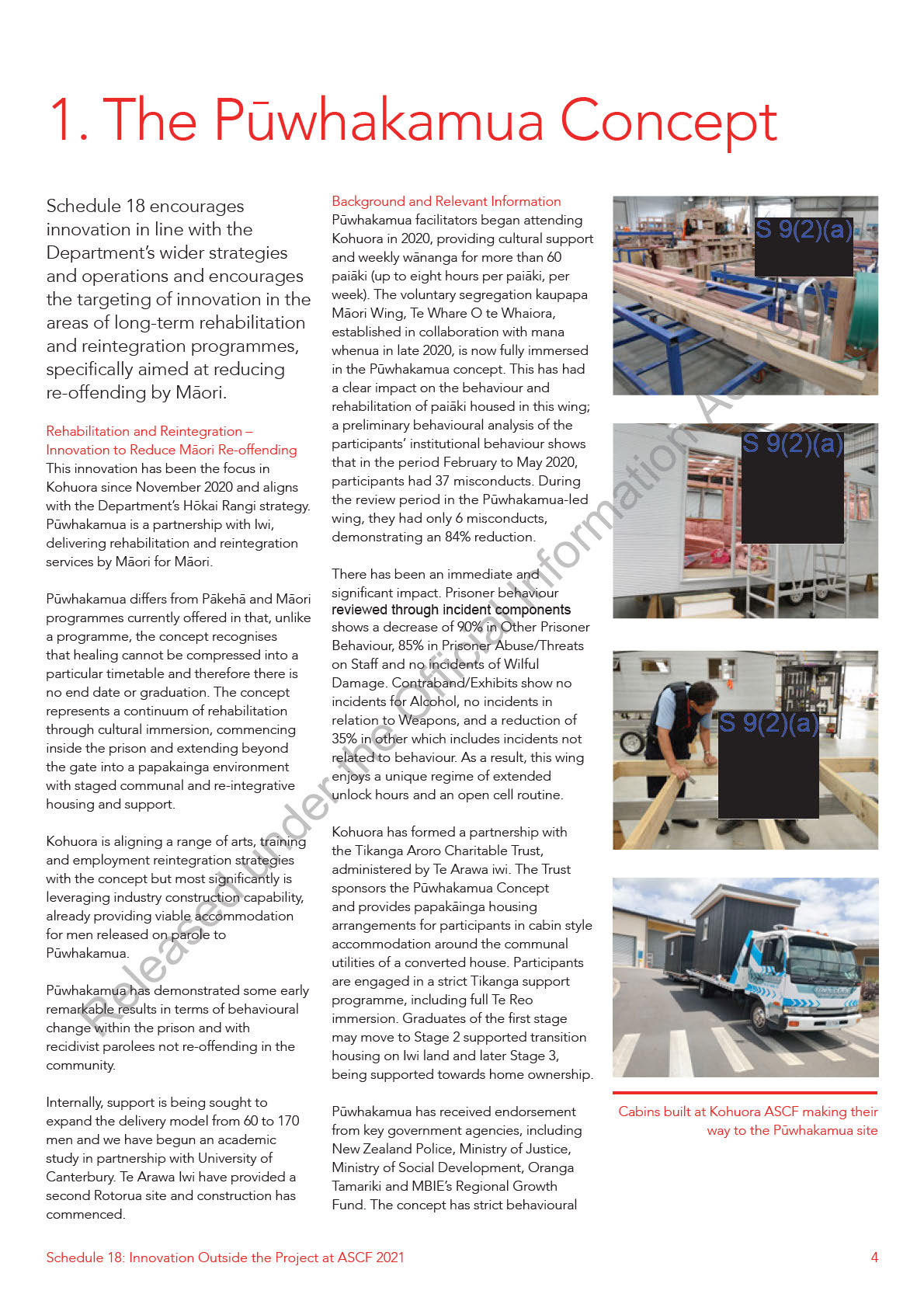
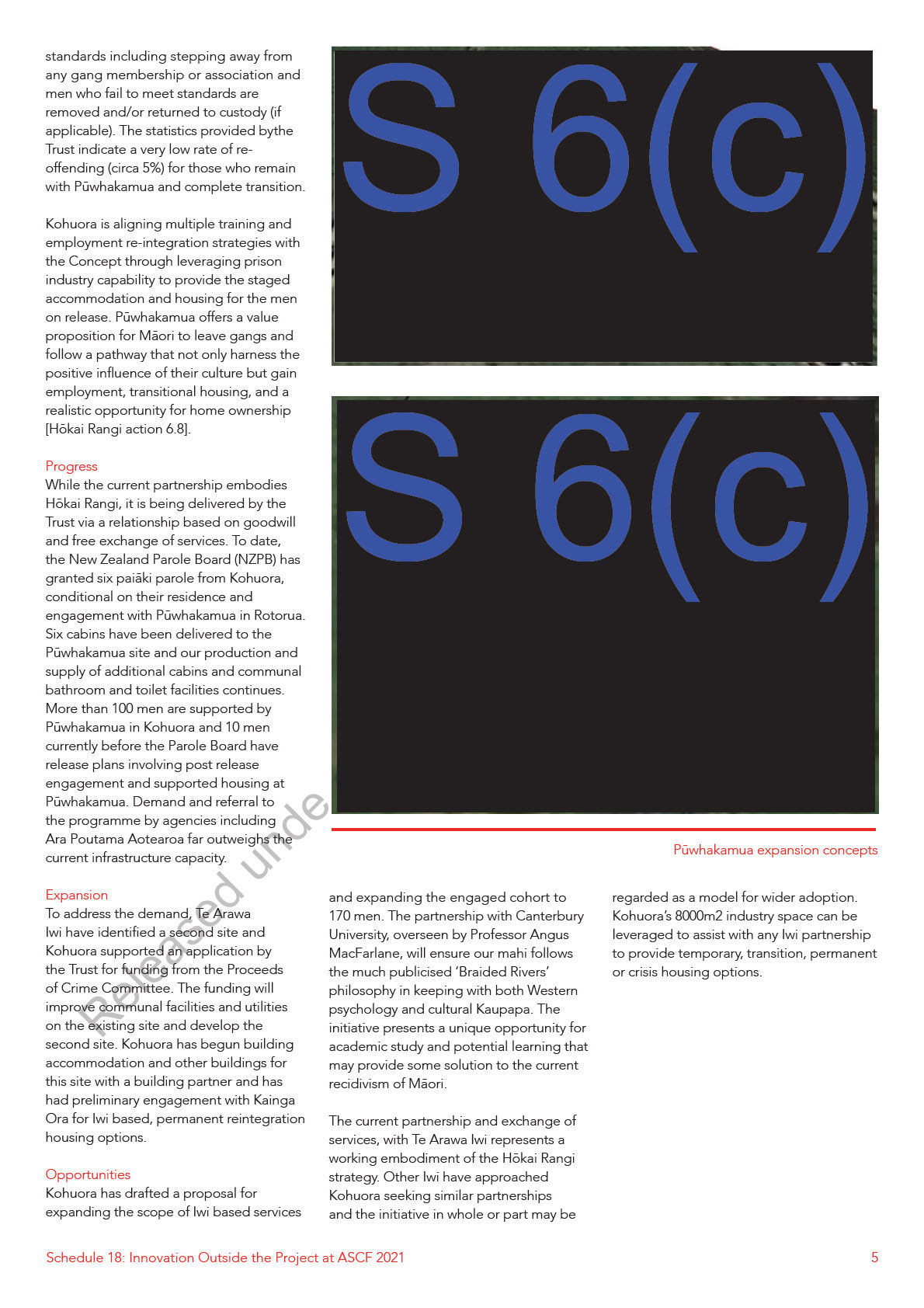
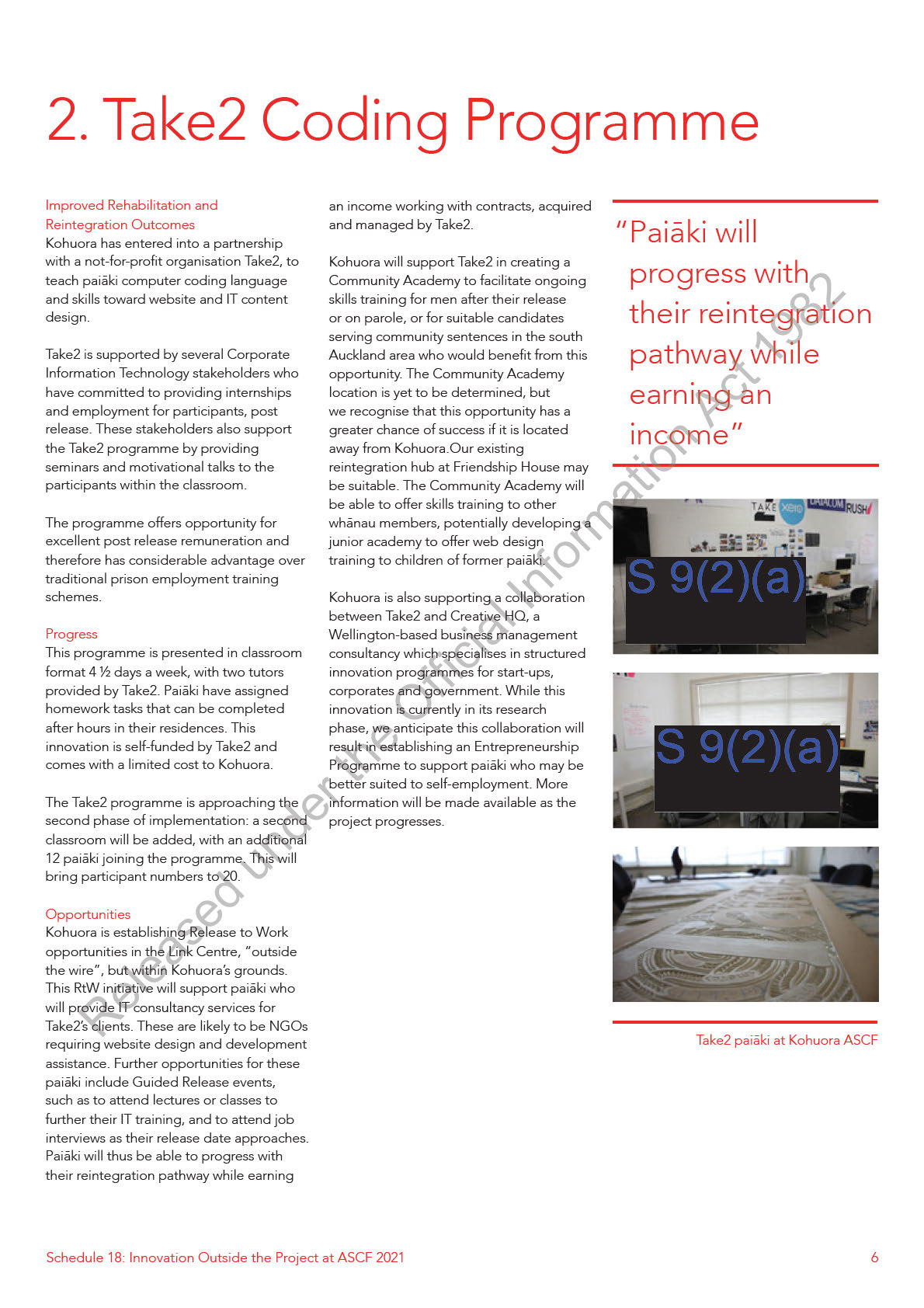
3. Video
Conference Suites
Improved Rehabilitation Outcomes
extension of the existing prisoner in-cell
Hōkai Rangi calls for us to take new
telephone network. The first phase of pilot
“ Video call rooms
approaches with paiāki placement, by
deployment will be a dedicated suite on
placing and keeping people in our care
the first floor of each House Block and in
and management as close as possible to
Residential self-care. Two further suites will
[will be] available
their whānau [Hōkai Rangi action 3.2]. At
be installed in the visits area.
Kohuora, we consistently receive paiāki
in every House
who have been sentenced out of region,
Unify Video Conference System is an
who have little to no support in Tāmaki
end-to-end encrypted secure video calling
Block and within
Makaurau.
platform, designed to connect occupants
of secure facilities with friends and whānau.
the Residences
We have explored ways of connecting
With tight pre-connection controls and
our men with their whānau, particularly
ongoing post-connection facial recognition
complex…
when they are out of region [Hōkai Rangi
technology, Video Conference affords
action 3.3]. The system aligns with our
the benefits of ongoing face to face
supported by
cultural engagement initiatives and services communication whilst also minimising risk
delivered by Iwi, engaging whānau in case
to all involved.
planning and conferencing, reintegration
staff.”
and reconciliation (humanising and
The system allows:
healing).
• Sign-up, registration of email address and
cross referencing of approved telephone
Additional Opportunities
During emergency management and in
number
The Department of Corrections may be
compassionate circumstances Kohuora
• Verification of identification and image of
able to replicate this technology in other
has used video conferencing, physically
external user (approved visitor)
prisons.
enabled and supervised by a staff member.
• Prison approval and authorisation
Our ICT resources have examined
• In Cell booking - visitor acceptance
corrections industry-specific solutions
• Facial Recognition of approved
and we are pleased to announce that
participant
hardware is currently being installed and
• Recording, monitoring and termination
will be operational in November 2021, to
capability
e Official Information Act 1982
provide a secure video conference system
in Kohuora.
S 6(c)
The Unify Video Conference System has
been preferred for our Pilot because of
ease of installation and deployment. This
und
was a paramount consideration because
Progress
of the demographics of our cohort and the
The timeframe for rollout of this initiative is
urgent need for a more readily available
pictured below (date subject to change due
and secure service. The Unify system is an
to recent Covid-19 lockdown measures).
sed
S 6(c)
Schedule 18: Innovation Outside the Project at ASCF 2021
7
4. External Worker Duress Alarm
Staff Safety and Escort Security
S 6(c)
predefined session or appointment, if no
Improvement
check call from the device is completed.
This innovation involves the adaptation of
readily available and proven remote worker
There would therefore appear to be
duress alarm technology to the corrections
scope for assessing the value of this
operating environment. The innovation
technology as an additional layer of
improves the safety of staff involved in a
security for community-based staff working
range of off-site work.
independently and interacting with former
offenders and offenders serving community
The alarm is a key-fob type device that
sentences. The devices are commonly
can be provided to staff when undertaking
used by the elderly as a fall/distress
escort duties such as Guided Release,
alarm. Additionally, there are a number of
Release to Work transport, Compassionate
Serco h ave exam ined differ ent bran
ded
reputable 24/7 alarm monitoring services,
Release, External Work Party and Hospital
devices for suitability and adaptability to
some linked to particular products.
Guard duties. The device and supporting
our operations. The current device has
application use a combination of mobile
been i den tified as the mo st s uita ble fo r a
Opportunities for the Department to Test
ation Act 1982
broadband communication and GPS
pilot pr ogr a
mme from the tec hnical an
d
the identified innovation
positioning, allowing for web-based
configur able perspective
and was
location visibility and alert response
de
ployed for use r acc eptance test ing.
management.
S 6(c)
Operationa ltestin
g result
s wer
e positive,
Intended Alarm Use
s
o fiv
e device
s hav
e no
w bee
n procured
an
d ar
e bein
g issue
d t
o escor tstaf fa
s part
o fth
e pilo tprogramme .I ti
s anticipated
tha tth
e us
e o fth
e dures
s alarm
s wil
S 6(c)be mandated as part of our standard
operatin
g procedur
e fo ral lexternal
escorts.
Opportunities for the Innovation to be
Applie
d i
n o rprovide
d t
o th
e Department’s
the Official Infor
Operation
s o rstrategie
s outsid
e the
Project
Device
s usin
g thi
s technolog
y ar
e readily
availabl
e an
d ca
n b
e configure
d to
differen toperatin
g environments .Serco
ha
s focusse
d o
n adaptin
g th
e technology
t
o mitigat
e th
e vulnerabilit
y o fstaff
conductin
g mobil
e an
d stati
c escort
s of
prisoners. The device has additional value
i
n enablin
g th
e trackin
g o fan
y pursui tand
providin
g a
n effectiv
e mean
s o fmobile
commentary .Wit
h th
e prevalenc
e of
securit
y incident
s durin
g externa lescorts,
th
e Departmen tma
y conside rthi
s o ra
similar adaptation of mobile duress alarm
technolog
y fo rthei rcustodia loperations.
Th
e technolog
y ha
s wide rfunctionality
wit
h th
e abilit
y t
o se tsessio
n time
s and
movemen tboundaries .Trackin
g ca
n be
continual
y activate
d throug
h an
y pre-set
time or location parameters. Alarms /
alerts can be automated at the end of a
Schedule 18: Innovation Outside the Project at ASCF 2021
8

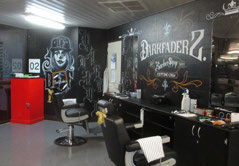
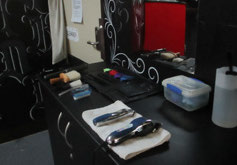
5. Barber Shop
Reques tfro
m Norther
n Regio
n
The fully functioning barber shop has
Leadershi
p Team
been established in the foyer area of the
This innovation project is one of many
“ Paiāki [will
House Block, to enable access to all paiāki
smal e rinitiative
s acros
s Kohuor
a designe
d
in House Block 1. Two barber chairs have
t
o provid
e skil
s trainin
g an
d potentia l
been installed along with the required
complete] courses
post-release employment opportunities in
cabinetry and two mirrors placed securely
a wid
e rang
e o foccupations .I ti
s include
d
on the walls.
to ensure their
i
n th
e Innovatio
n Repor tfol owin
g
a recen t
visi tt
o Kohuor
a b
y th
e Norther
n Regio
n
The Dark Faderz brand was designed,
communication
Leadershi
p Team .Member
s o fth
e NRL
T
developed and painted by paiāki.
wer
e s
o impresse
d b
y thi
s initiative ,the
y
skills and
requeste
d furthe rdetail
s t
o implemen t
Bookings are made via a booking system
thi
s i
n othe rprison
s withi
n th
e Norther
n
run by the barbers, who have developed
understanding
Region .
the skills to maintain this.
Improved Rehabilitation and
are appropriate
Paiāki have a similar experience as those
Reintegratio
n Outcomes
in the community through booking and
A Barbe rSho
p wa
s se tu
p i
n Hous
e Bloc
k
receiving barber services.
for customer
1 and is staffed by a member of the
Hygiene is maintained through a central
Educatio
n Tea
m qualifie
d i
n hairdressin
g
place for hair cutting.
interaction.”
trainin
g an
d paiāk iwh
o ar
e undertakin
g
the Barber course. Prior to acceptance
Progress
o
n th
e Barbe rcourse ,paiāk icomplet
e
The Barber Shop is running as intended. A
th
e Si
x Thinkin
g Hat
s programm
e an
d
a
hairdressing wash basin will be installed for
Trai
n th
e Traine rcourse ,t
o ensur
e thei r
shampooing.
communicatio
n skil
s an
d understandin
g
ar
e appropriat
e fo rcustome rinteraction ,
Additional Opportunities
an
d the
y hav
e develope
d confidenc
e an
d
This concept could be replicated in other
mentorin
g skil s.
House Blocks and prisons with the requisite
oversight.
Th
e cours
e i
s 1
0 week
s long ,wit
h 31
0
practica lan
d theor
y learnin
g hours .Paiāk i
Looking Forward
wil lgai
n 3
1 NZQ
A Leve l
2 an
d
3 credits .
As the House Block 1 barber shop is
available to voluntary segregated prisoners
Th
e cours
e i
s ru
n i
n partnershi
p wit
h th
e
only, stage 2 will see similar opportunities
UCO
L Schoo lo fTechnolog
y t
o mee tth
e
within House Blocks 2 and 3. Alternatively,
under the Official Information Act 1982
expecte
d standard
s o fth
e Hairdressing
a cabin could be converted into an on-
Industr
y Trainin
g Organisation .Al
site barbershop inside the wire, to allow
equipmen tan
d product
s ar
e i
n lin
e with
mainstream paiāki the same opportunities
th
e requisit
e Healt
h an
d Safet
y standards ,
to gain skills and earn qualifications while
s
o paiāk ica
n gai
n skil
s an
d qualification
s
cutting hair for mainstream paiāki.
t
o th
e sam
e standar
d a
s i fthe
y wer
e
in the community. They can use this
experienc
e toward
s furthe rqualifications,
an apprenticeship or employment through
Released
Release t o Work, po st-rele ase
employment or potential y develop their
ow
n businesses .
The Dark Faderz Barber Shop
Schedule 18: Innovation Outside the Project at ASCF 2021
9
6. Appendix
under the Official Information Act 1982
Released
Schedule 18: Innovation Outside the Project at ASCF 2021
10
Take2 Coding
under the Official Information Act 1982
Released
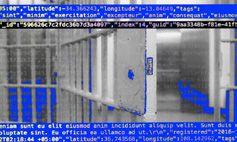
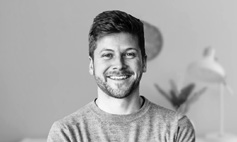
https://thespinoff.co.nz/business/29-08-2021/the-prisoners-learning-the-worlds-most-valuable-skill/
The prisoners learning the world’s most valuable skill
August 29, 2021
Michael Andrew | Business editor
Ten inmates at a high security
like teamwork, self-worth, community,
“Some individuals may have made a
South Auckland prison are being manaakitanga.
mistake two years ago or even five years
Take2 Students (Photo: Michael Andrew)
ago, and they had served their time
equipped with skills that court
It’s almost as though we are sitting in
according to our justice system,” he says.
lucrative roles in tech companies the office of a particularly progressive
“But we as a society are actually serving a
all over the world. But do they
tech company somewhere in downtown
second sentence to these individuals, which
actually have a chance at being
Auckland, and he’s telling me about what
is often lifelong for them. This impacts their
he does for a job. But we aren’t. We’re
families and contributes to cycles of crime.”
employed once released?
sitting in a classroom in the middle of the
Michael Andrew went along to
Serco-run Auckland South Corrections
A few years ago, after being diagnosed
the class to find out.
Facility, where the man is serving a two year
with an serious autoimmune disease
sentence for aggravated robbery.
and ending up in hospital, Smith began
reevaluating his own purpose and decided
If the crime sounds jarring, it’s supposed
he would devote his energy to the area of
to. Violent thieves are not people we
society he felt needed it most.
readily forgive in New Zealand. But in
Take2, the programme teaching a small
He left his full-time job to take a deep dive
group of prisoners how to code, reidentify
into the world of prisoner rehabilitation
themselves and improve their lives, the
and came across The Last Mile, the US
misdeeds of the past do not define who
programme where incarcerated people
someone is today.
are taught coding and other critical skills,
Tina Tiller
and are then employed by tech companies
Nearing the end of a 12-month pilot, Take2
like Slack and Adobe upon release. The
A man sits at a computer typing in a foreign has proved to be enormously successful,
programme has successfully returned 313
language. He types deftly, confidently, each having taught the students intermediate
citizens back into society and boasts a
sequence of random characters appearing
web and app development through a
0% recidivism rate among its graduates.
on the black window in a different pastel
handful of programming languages. It also
Smith began liaising with the programme
colour, like a birthday card written by a
boasts the highest engagement rate and
directors, travelled to the US to observe the
child with a crayon set. As he types, there’s
lowest absenteeism of any of the prison’s
programme, and came back with a model
movement on a web page on a second
programmes.
on which to base New Zealand’s version.
monitor; its colour and font changing.
“We’re not buying into the stigma of
After a few moments, the man stops
‘once a prisoner always a prisoner,’’ says
typing, leaves the cursor blinking at its
Cameron Smith, Take2’s founder and CEO.
position after the final typed word – <div
“The worst thing is to have these guys
class=”div3”> – and turns to me.
going back to the outside world without
under the Official Information Act 1982
any skills or any opportunity. What we’re
“At first glance it looks complicated,” he
doing is providing them hope. It’s about
says, gesturing at the screen. “But they
allowing them to improve their quality of
break it down to make it really easy to
life.”
understand. We started learning by playing
Cameron Smith (Photo: Supplied)
Minecraft. But now the latest language I’m
Broken system
learning is React.”
New Zealand has one of the highest per
After approaching Serco with his idea,
capita incarceration rates in the OECD, with Smith was told it would be considered if
Soft-spoken and pleasant, he smiles as
a reoffending rate of 50%. Māori represent
he managed to find enough funding and
Released
he speaks, evidently enjoying explaining
over 50% of the prison population, despite
external support. So he did. After engaging
the pleasures of web development to a
only making up 15% of the overall New
NZTE and private investors – including NBR
complete layman. “It’s quite advanced. But
Zealand population.
Rich Lister Andrew Bagnall – and forming
all it takes is persistence and discipline, and
an advisory board through his old networks,
when you see it come to life on this other
Smith started Take2 in an attempt to
he raised the $220k seed funding that
screen, it’s like a moment of euphoria, or a
find a new tool to fix the broken system.
would allow him to go back to Serco with a
drug. A healthy one though. And then you
Having worked in impact investment
business case.
think, ‘what else can I do?’ And you go and
and recruitment, he had witnessed the
do more research.”
permanent stain a conviction can have on
Francois Meyer, the prison’s assistant
Around the room are other men working
someone’s job prospects, and the influence
director of rehabilitation and reintegration,
at computers; on the walls are posters with
the stigma has on their reoffending.
told The Spinoff he receives all kinds of
mind maps and diagrams espousing values
pitches for new programmes, few of which
https://thespinoff.co.nz/business/29-08-2021/the-prisoners-learning-the-worlds-most-valuable-skill/
come to fruition. He suspected it would
Datacom New Zealand is another employer of Take2 is how it has addressed the risk
be the same when Smith first approached
that has committed to providing an
of students using their new digital skills
him. “The system is not easy,” says Meyer.
internship programme for Take2 graduates.
for nefarious purposes. Naturally, Smith
“It takes a long time to adapt. I thought I
Managing director Justin Gray says he will
maintains the same position on potential
wouldn’t see Cam again. But he has a drive
be taking two students from the original
cyber crime as any other recidivism – just
and vision that has been spectacular. He
cohort into roles at the company. “We
because the students have offended in the
came back after three months with all this
want to help them with that next part of
past doesn’t mean they will do it again.
funding and I said, ‘let’s do it’.
the journey,” Gray says, emphasising the
need for the new recruits to be entering an
In fact, many of those working with the
Employer participation
supportive and nurturing environment.
programme are former prisoners or
In order to prove that the programme
reformed offenders themselves. Motivational
was viable, Smith had to leverage advice
“I would love us, in another six or 12
speaker and former convict Dr Paul Wood
from a range of different stakeholders and
months’ time, to be able to point to some
has spoken with the students, and the class
experts to craft a holistic curriculum, one
great examples of people who’ve not only
teacher, Kirsty Gainfort, had a close brush
that would prepare the students for lasting
gone through the programme, but actually
with the law in an earlier life when she used
reintegration and potential employment in
successfully transitioned into meaningful
her coding and programming skills for what
the tech sector.
employment that’s great for them, great
she calls “illegal purposes”. Smith says
for their families, great for the companies
bringing in successful and talented people
But the most important step was finding
they’ve joined.”
with lived experience of the system creates
companies to commit to hiring prisoners
a relatability that allows the students to
who completed the programme, which,
While Gray knows the importance of
connect, build rapport and have accessible
according to Smith, was relatively easy.
nurturing home-grown talent for the tech
role models.
sector, he never considered prisons as a
One of Take2’s earliest business partners
potential source of employees. However,
But perhaps the most unique security
was Rush, the design and technology
having met Smith and being exposed to
measure is the in-class learning platform
studio behind the government’s Covid-19
his “infectious” determination to address
that was developed to function without a
tracer app. Rush CEO Pavan Vyas says he
New Zealand’s incarceration crisis, he said
connection to the internet. A kind of “safe
supported Take2 as it would allow people
involving Datacom was an easy decision.
mode”, the platform was built by Datacom
from different backgrounds to enter the
and the prison’s IT team, and allows the
rapidly-growing tech sector, which was
“It ties in with our broader vision of
students to learn web development while
already facing a severe worker shortage
helping to build digital skills in a way that’s
protecting internal networks and servers.
and lack of diversity. The company is
equitable across the community. As soon
setting up an internship programme
as we heard about it [Take2], it was a no-
So are the students really skilled enough to
which will see Take2 students working for
brainer for us to support it.”
hypothetically hack into the prison system?
Rush as part of their reintegration into the
Given they’ve learned without any access
workforce.
With the backing of Tate Communications,
to the internet, probably not. But Juan de
the Tindall Foundation, Jr McKenzie trust,
Roock, senior manager for engineering and
“We know some of these people are highly
and the Spark Foundation, Take2 has raised customer applications at Air New Zealand
creative and highly intelligent, and yet
$1.25m for future operations, and Serco
– another participating employer – says
they’ve made some really poor decisions
is planning to open a second classroom
the students’ programming knowledge
early in life.
within the prison.
is beyond the level of an entry level
developer.
under the Official Information Act 1982
“So how does business nurture them and
Critically, there’s also the immensely
“I brought a colleague with me and had
take the bold steps and employ some of
valuable support of the Department
him observe and test their knowledge,”
these people to reintegrate them back into
of Corrections, which sees Take2 as a
says de Roock. “The feedback was that
society?”
unique addition to its portfolio of prisoner
they are closer to intermediate developers
rehabilitation programmes, most of which
– they know more than juniors coming out
Vyas, who is now an independent Take2
are based around construction, trades and
of uni. And that was fascinating. Because
director, is fully aware of the stigma that
primary industry training.
these guys had only been coding for four
former offenders face, and how it can be a
to six months.”
barrier to employment. However, he said
“Cam is a bit of a powerhouse in terms
Released
much of what the general public knows
of the passion he’s got and the work he’s
While de Roock attributes their rapid
about the prison system comes from the
doing and the network he’s built with
development to the quality of the
media and films, which typically peddle
the tech sector,” says Department of
curriculum, which couples coding
simplistic and biased portrayals.
Corrections CEO Jeremy Lightfoot. “The
fundamentals with a clear goal-oriented
pilot phase has proven the value and
approach in which the students can monitor
“It’s human nature to be apprehensive
impact… and it’s now about what we can
their progress, he said the lack of internet
about things we don’t understand. But
do to get it scaled up to a level that can
connection takes away convenience and
it’s about actually opening the doors and
start to have broader impacts.”
forces them to learn how to solve problems
understanding and sending the message
the old fashioned way.
out to employees and employers that
Dangerous skills
knowledge and talent and capability exists
With cyber crime a growing threat in New
“So they’ve got to literally figure out every
at all levels.”
Zealand, one of the most unique aspects
problem themselves, or with the teacher.

https://thespinoff.co.nz/business/29-08-2021/the-prisoners-learning-the-worlds-most-valuable-skill/
They don’t have a choice. They can’t access
ones – and one of them is in the process of
bright and better future for myself and my
Stack Overflow or any library of resolutions.
making a carving that integrates traditional
family.”
They’ve got to stick it out, which is great!
Māori designs with bits of Java Script.
It’s definitely helping them progress faster
Once completed, the carving will sit in the
than normal.”
classroom where each participant can sign
it.
Class teacher Kirsty Gainfort agrees that
teaching a solid foundation of coding
basics has allowed the students to expand
their knowledge to multiple languages.
“It’s less complex than it looks. There are so
many different coding languages but the
fundamentals are really important. Once
they’ve got those down then they’re away
and it just gets easier,” she says.
Cameron Smith chatting with a student
(Photo: Michael Andrew)
The Take2 carving (Photo: Michael Andrew)
Not long after speaking with Gainfort,
two students get up from their desks
Māori capability consultant Atawhai Tibble
and approach me. “What’s the most
has been involved in guiding the tikanga
inconvenient thing about your job?” one
framework within Take2, and has been
of them asks. “Transcribing interviews,” I
“blown away” by the programme. “I could
reply. They huddle together to discuss it,
tell it wasn’t bullshit,” he says. “One of the
before returning to their desks, seemingly
guys showed me his website, and I knew it
pondering some kind of development
was his because it was a like a Bob Marley
solution to my administrative woes.
tribute page! And another guy had created
a website for his marae!
“They clearly want to understand what the
world is outside,” says de Roock. “They are
“They were genuinely excited and
definitely looking for similarities and are
interested. They were being looked after.
interested in what we do and how we do
The manaakitanga in the room was real.”
it.”
Being run out of a system that is widely
Self-worth
condemned as flawed, Take2 could easily
While the emphasis of Take2 is on learning
come under the same kind of doubt
web development, Smith says it’s far more
and criticism. After all, with only 10 initial
than just helping the students get cushy
students, its immediate impact isn’t likely to
jobs in the tech sector. Rather, he says, it’s
make a dent in New Zealand’s incarceration
about helping them see themselves in a
rate, nor in the tech worker shortage. On
positive light, not merely as offenders in the paper the whole programme could be
under the Official Information Act 1982
prison system, but as creative and valuable
perceived as a slick PR gimmick for Serco
people – fathers and sons and brothers;
and a few tech companies.
good men with hope for the future.
But in that classroom, it’s exceedingly
“We teach them development. But they
clear this isn’t the case. Pride, enthusiasm,
don’t have to go out and be developers,”
creativity, discipline; these are all the things
says Smith. “We want to support them in
being fostered in a genuinely empathetic
whatever way we can to set them up for
and attentive environment where students
success, however they want to define that
are not only learning code, but a far more
Released
in their life.
rare and essential skill – how to value
themselves.
“The better we know them, the more trust
they have in us. They know that we’re really
“Take2 really feels like a second chance
in their corner.”
at life and has been a healing experience
for me,” one student wrote about the
Which is why, alongside coding, the
programme. “The last few years leading up
students are also taught communication
to my imprisonment was a downward spiral
skills, meditation, breathing exercises, and
of failure and disappointment. Since then
aspects of Tikanga Māori. The students
Take2 has turned my life around.
practise tuakana teina – a mentorship
system between senior students and junior
“I feel happy, confident and can see a
External Worker Duress Alarm
under the Official Information Act 1982
Released
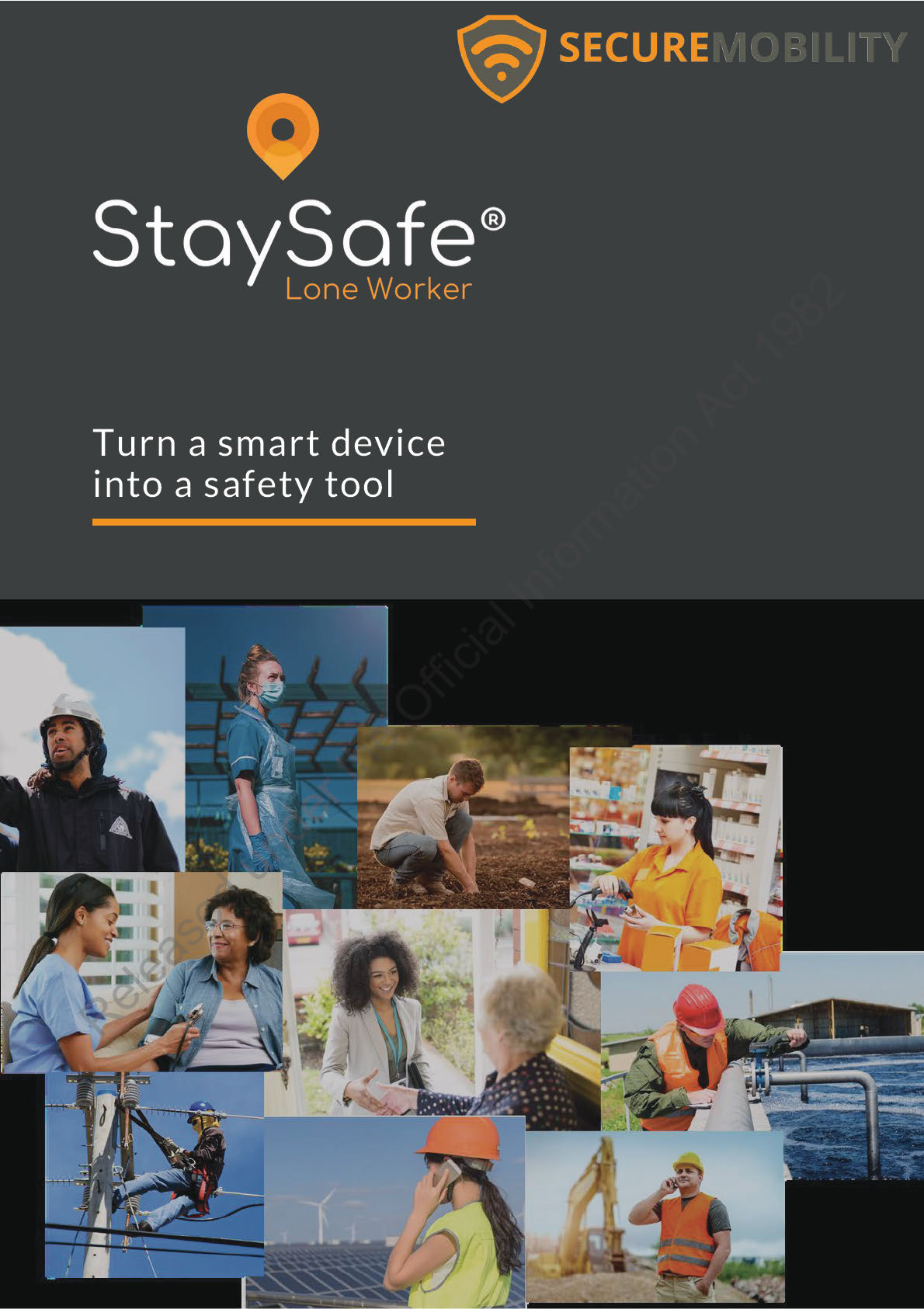
Contents
Do you have Lone Workers?.. . . . . . . . . . . . . . . . . . . . . . . . . . . . . . . . . . . . . . . . . . . . . . . . . . . . . . . . . . . . . . . . . . . . . . 1
Lone worker risks.. . . . . . . . . . . . . . . . . . . . . . . . . . . . . . . . . . . . . . . . . . . . . . . . . . . . . . . . . . . . . . . . . . . . . . . . . . . . . . . . 1
Legal duty of care. . . . . . . . . . . . . . . . . . . . . . . . . . . . . . . . . . . . . . . . . . . . . . . . . . . . . . . . . . . . . . . . . . . . . . . . . . . . . . . . 1
StaySafe lone worker solutions.. . . . . . . . . . . . . . . . . . . . . . . . . . . . . . . . . . . . . . . . . . . . . . . . . . . . . . . . . . . . . . . . . . . . 2
The App and Hub.. . . . . . . . . . . . . . . . . . . . . . . . . . . . . . . . . . . . . . . . . . . . . . . . . . . . . . . . . . . . . . . . . . . . . . . . . . . . . . . . 3
Features of the App. . . . . . . . . . . . . . . . . . . . . . . . . . . . . . . . . . . . . . . . . . . . . . . . . . . . . . . . . . . . . . . . . . . . . . . . . . . . . . 4
Features of the Hub.. . . . . . . . . . . . . . . . . . . . . . . . . . . . . . . . . . . . . . . . . . . . . . . . . . . . . . . . . . . . . . . . . . . . . . . . . . . . . .5
Customer testimonials.. . . . . . . . . . . . . . . . . . . . . . . . . . . . . . . . . . . . . . . . . . . . . . . . . . . . . . . . . . . . . . . . . . . . . . . . . . . .6
under the Official Information Act 1982
Released
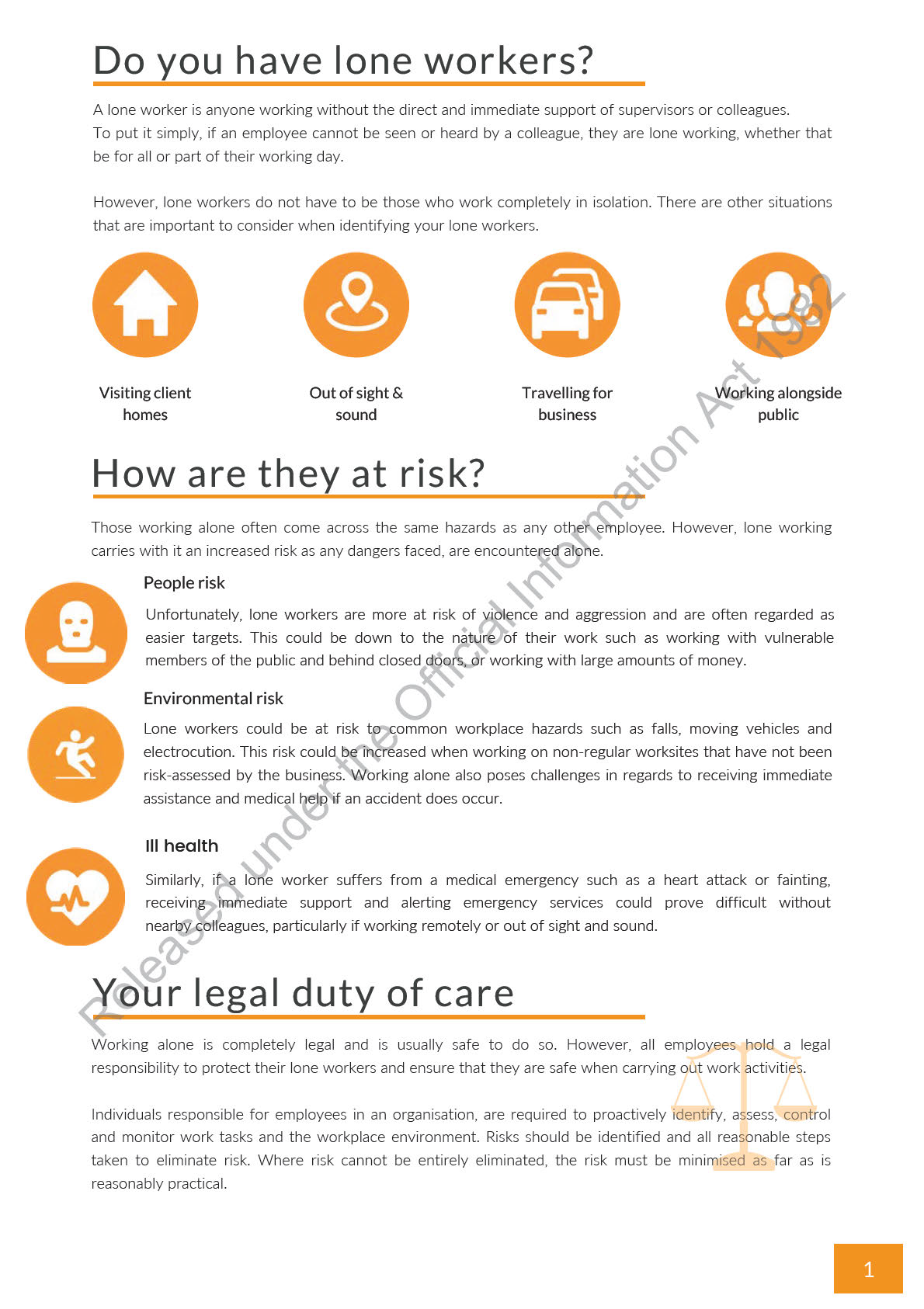
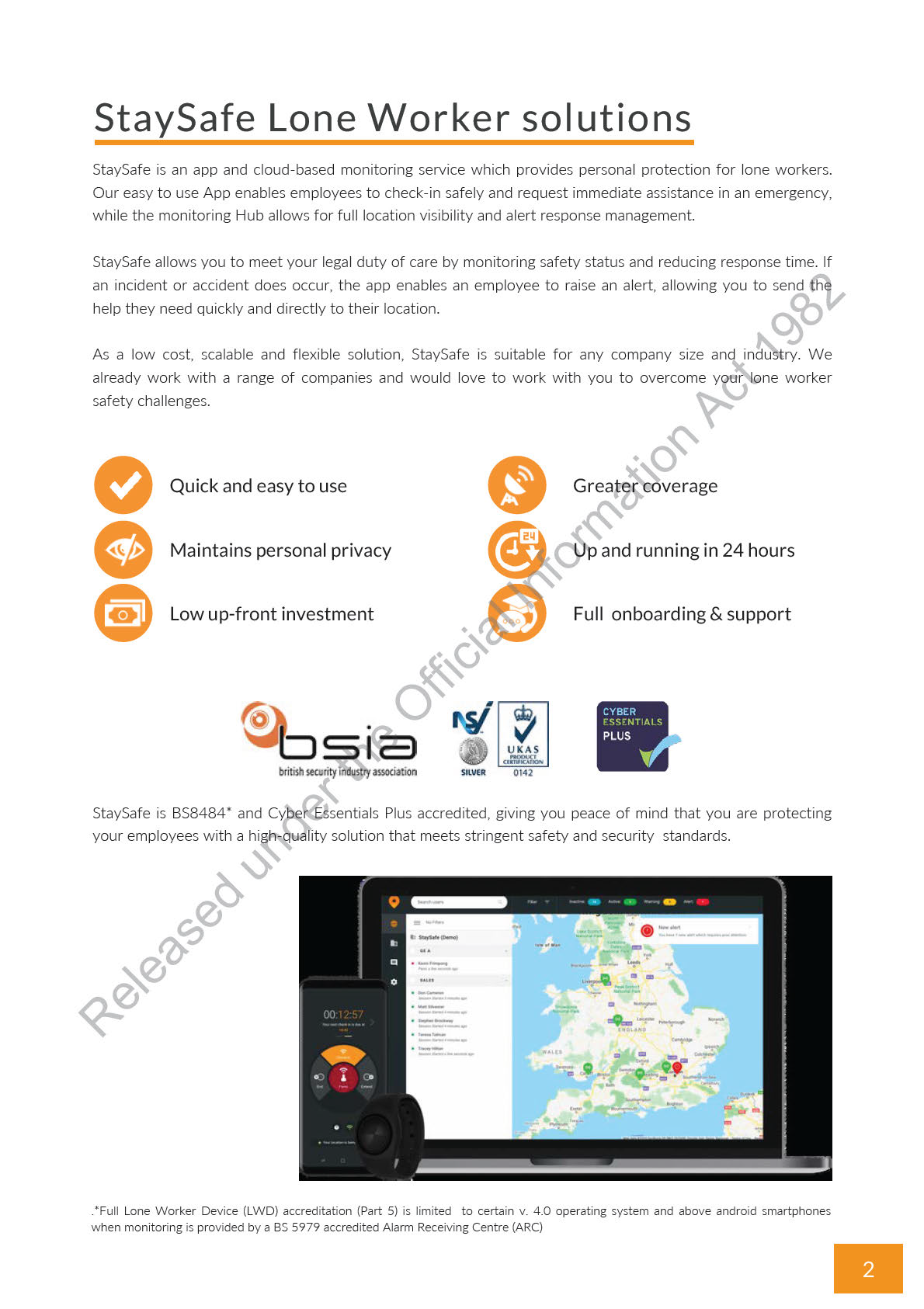
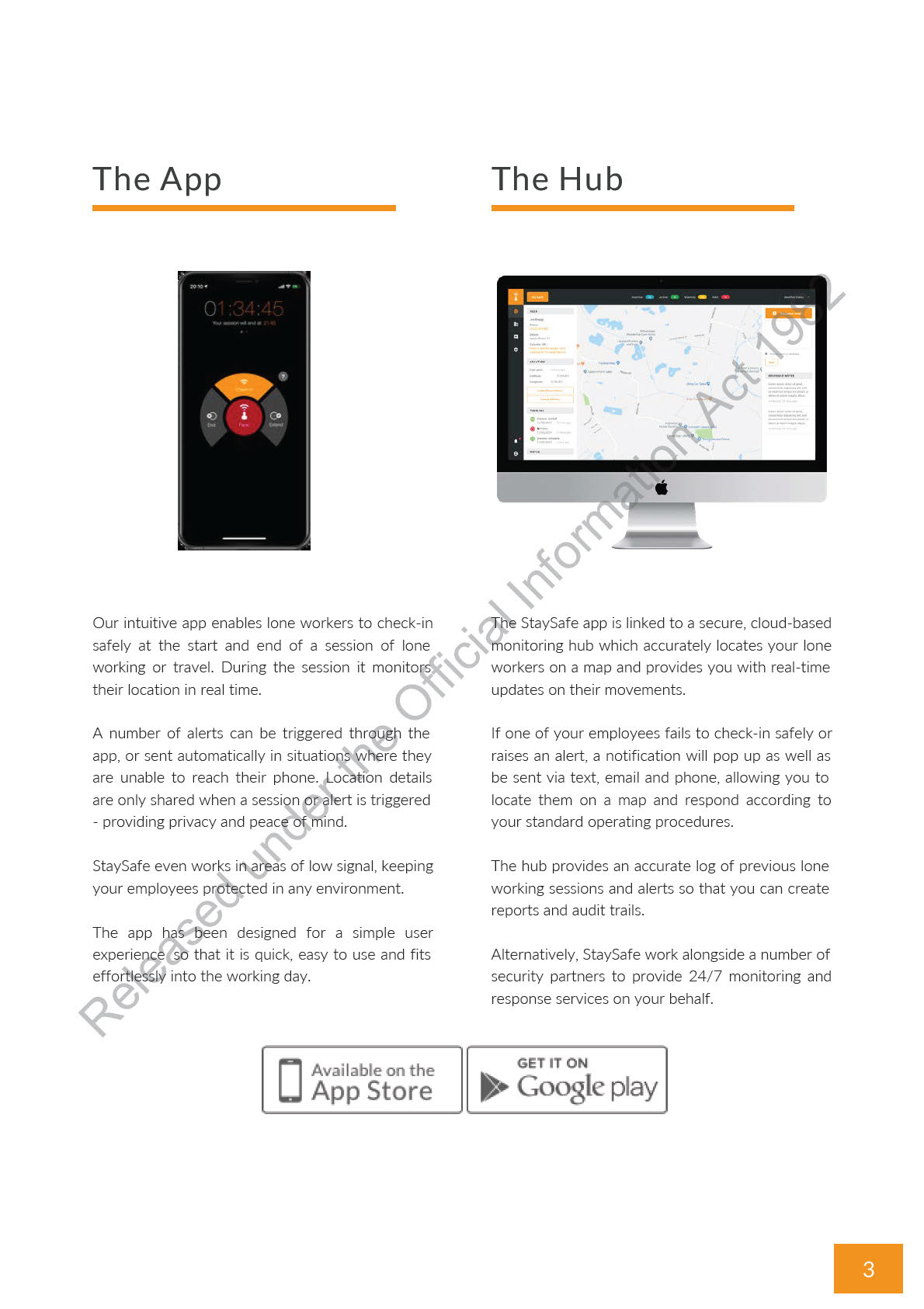
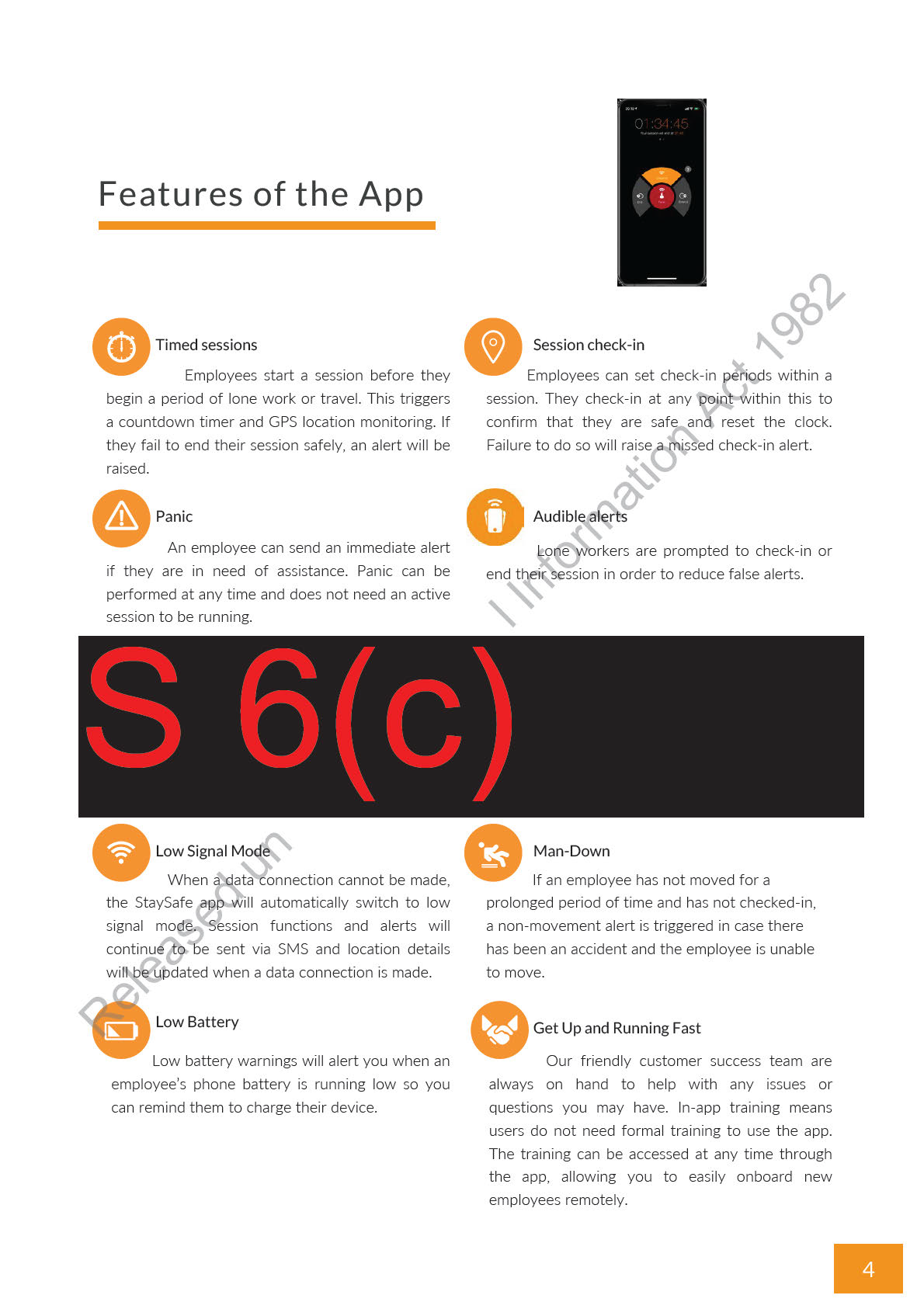
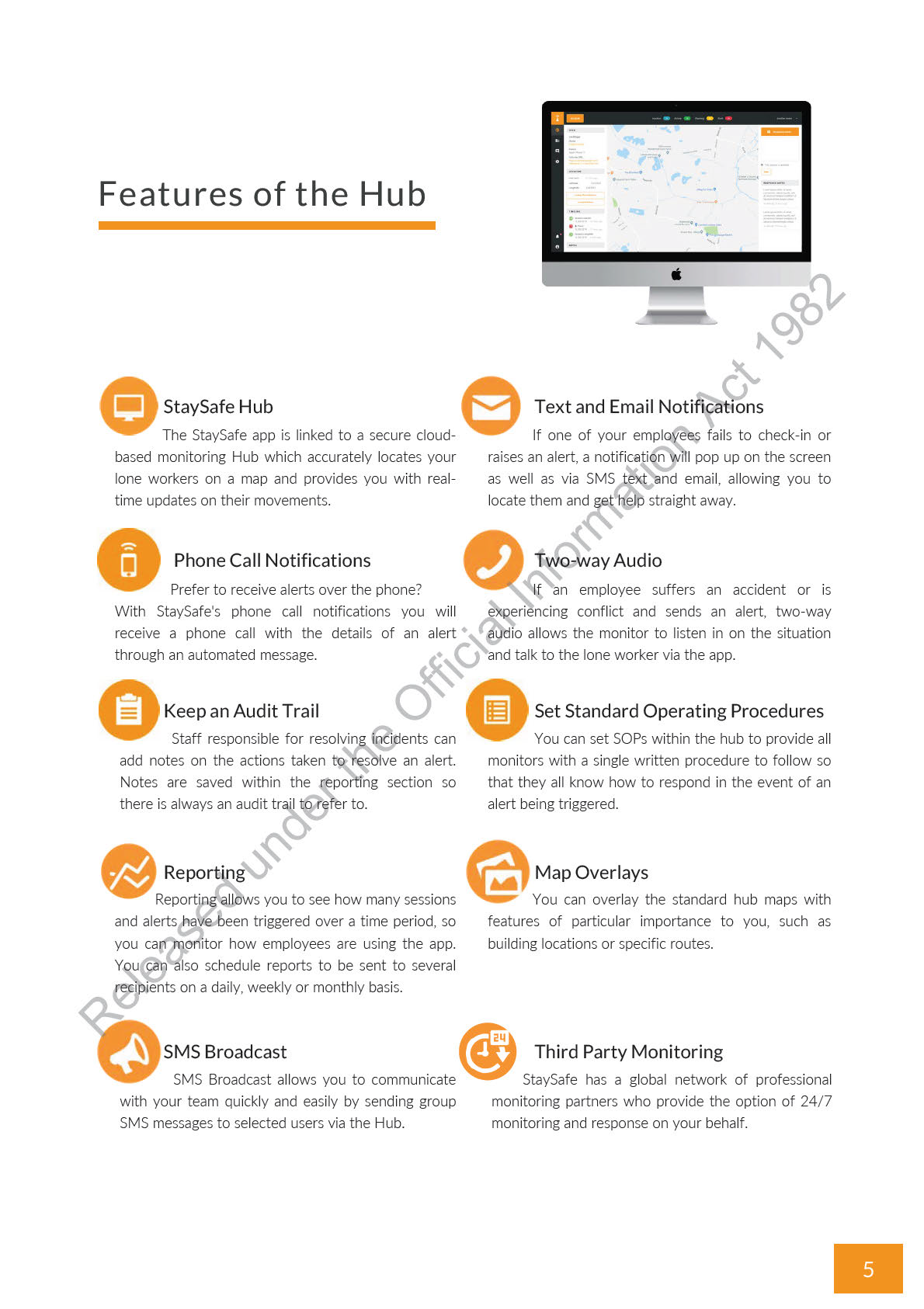
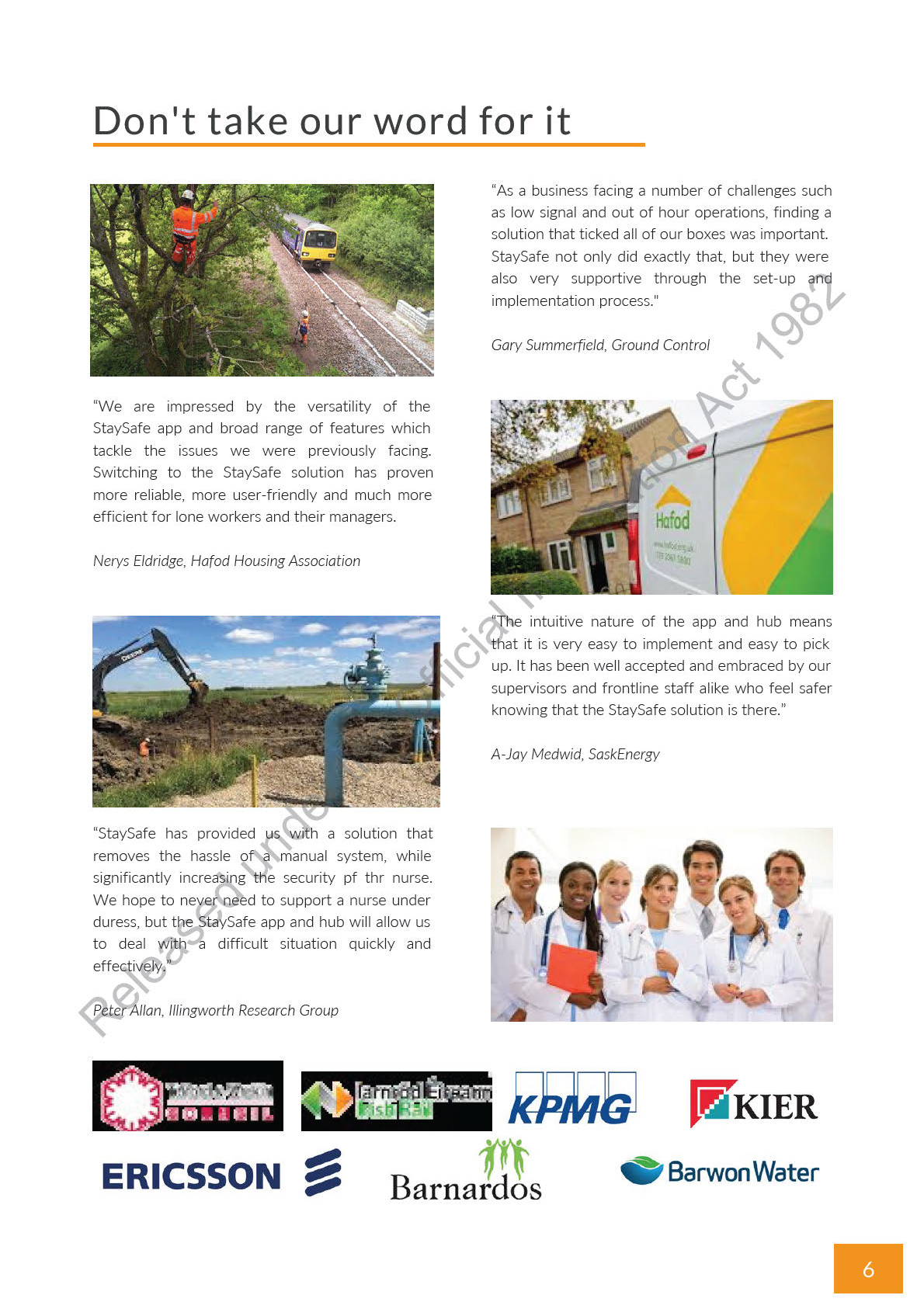

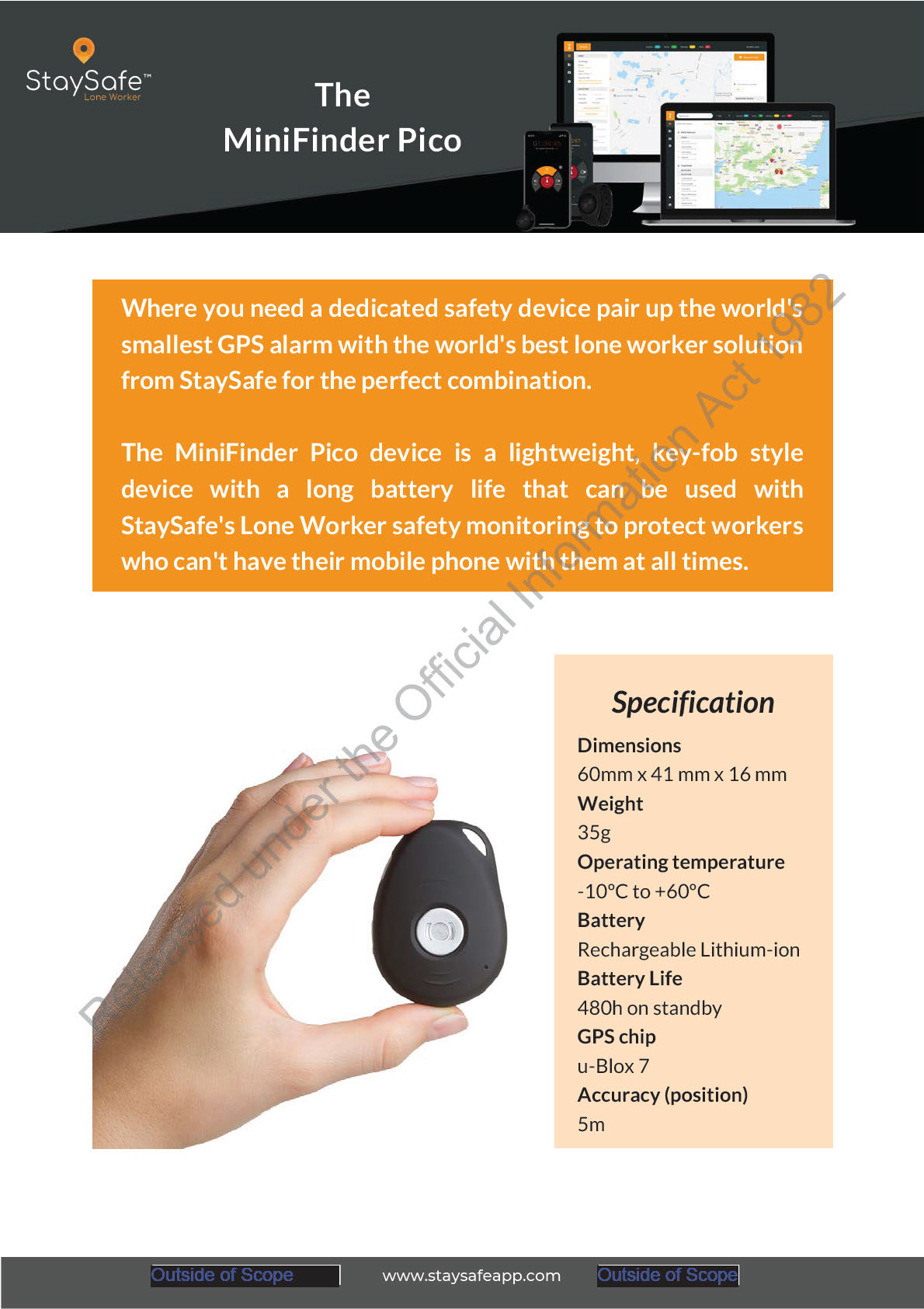
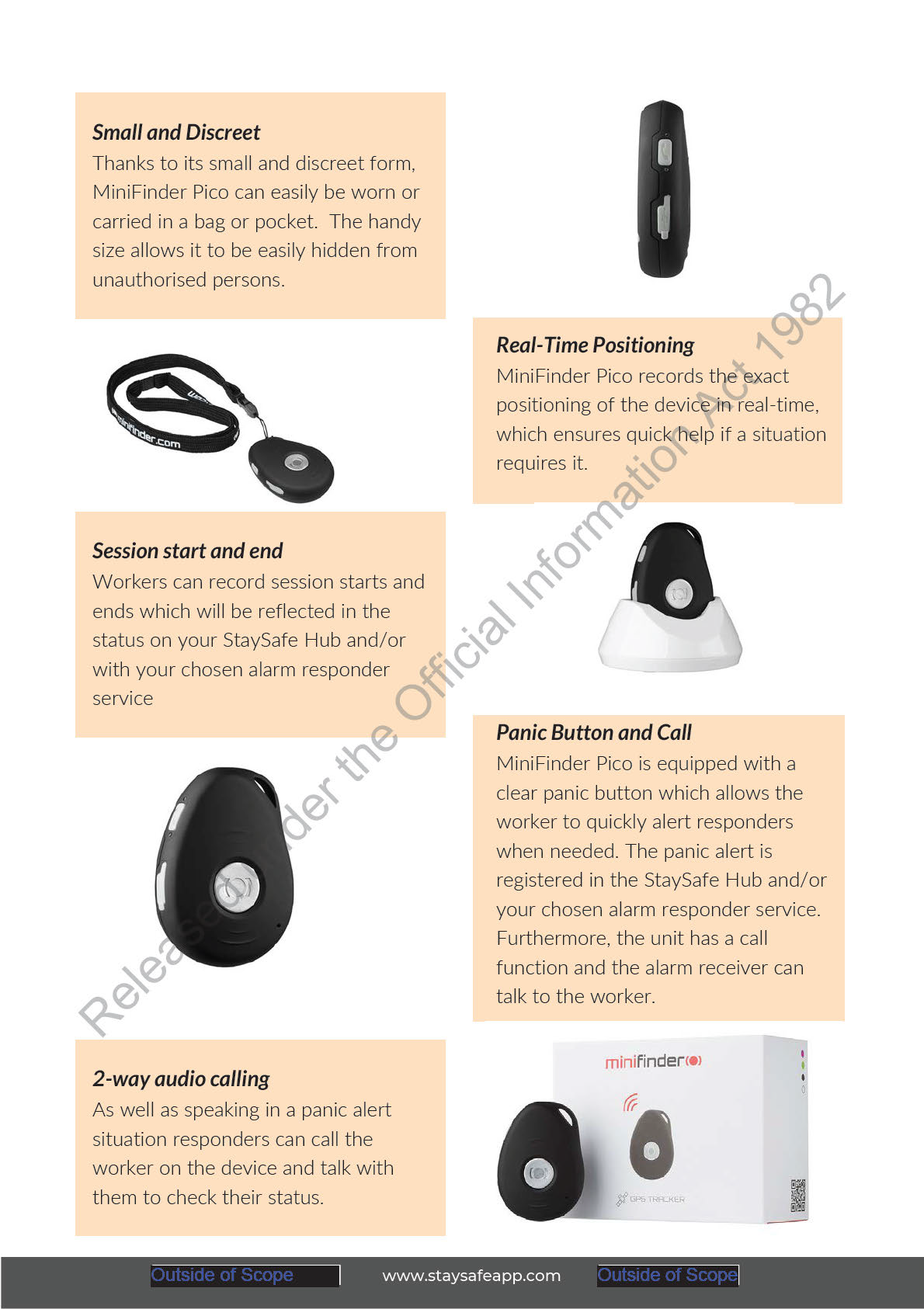
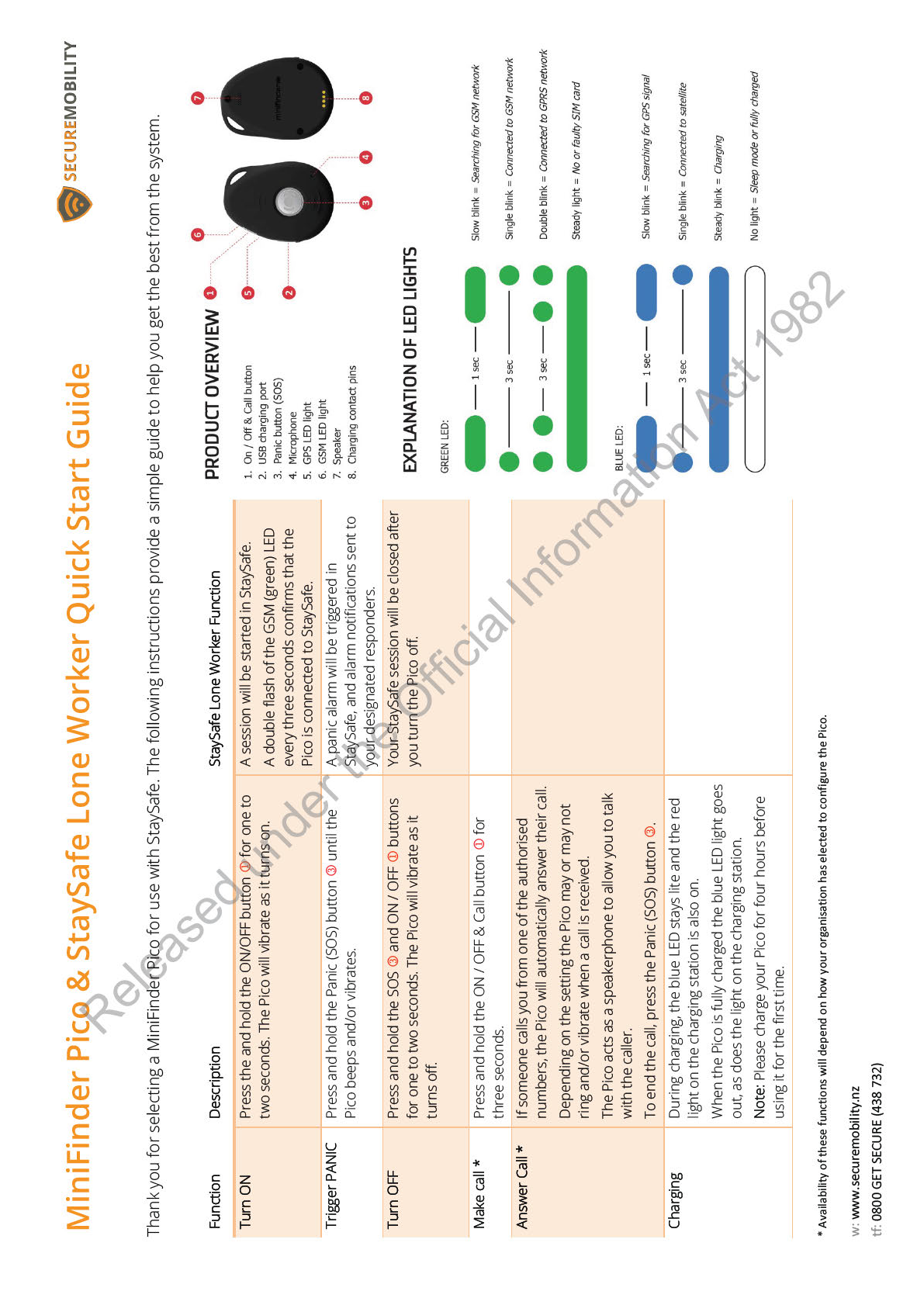
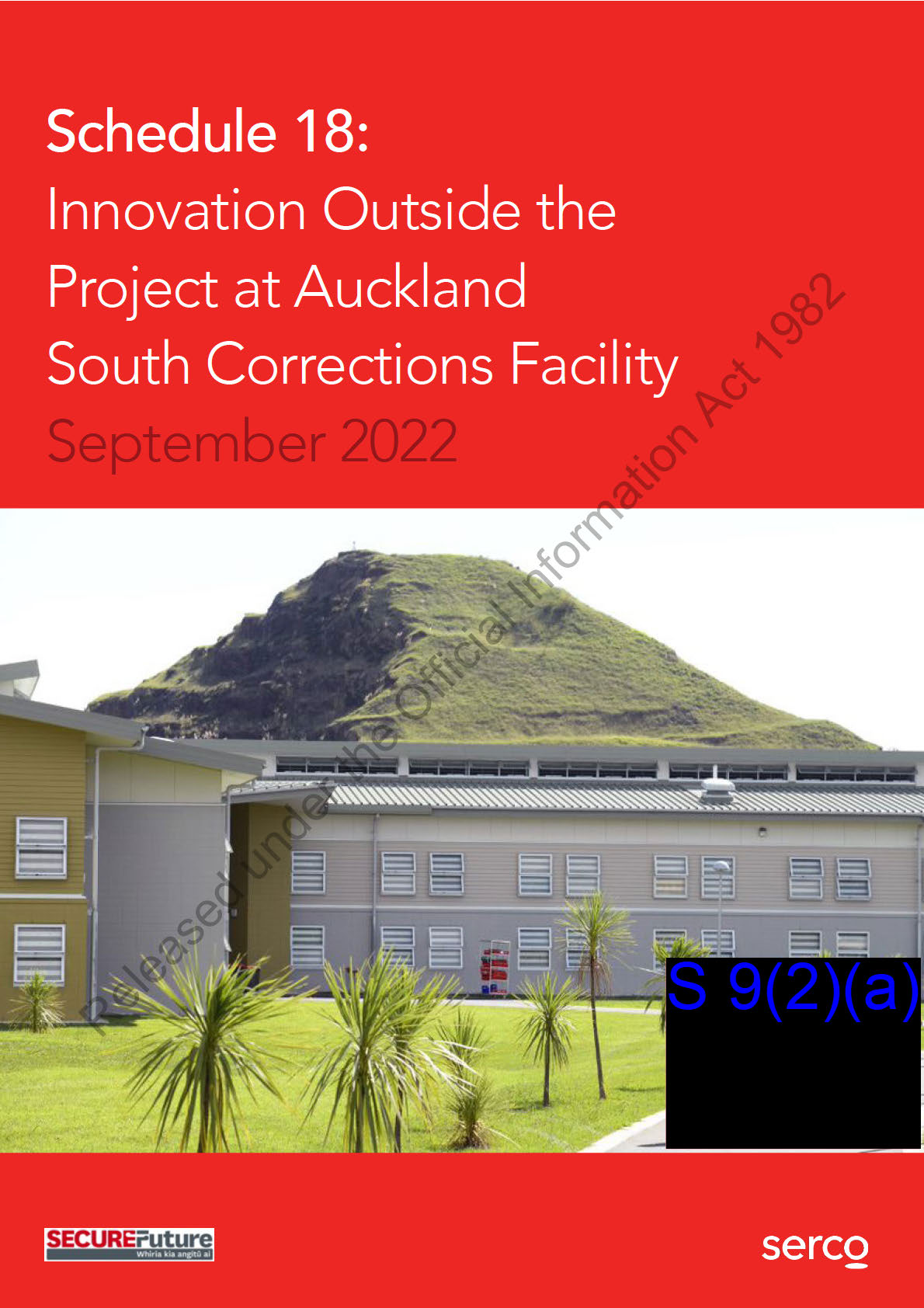
Contents
1.
The Year in Review
3
2.
Full Body Imaging Technology
4
3.
Hōkai Rangi: Cultural Wings
6
4.
Teams Phones
8
5. Cornerstone
9
6.
Matariki Celebrations
10
7.
Cleaner and Greener Oil Supply
11
under the Official Information Act 1982
Released
2
Schedule 18: Innovation Outside the Project at ASCF 2022
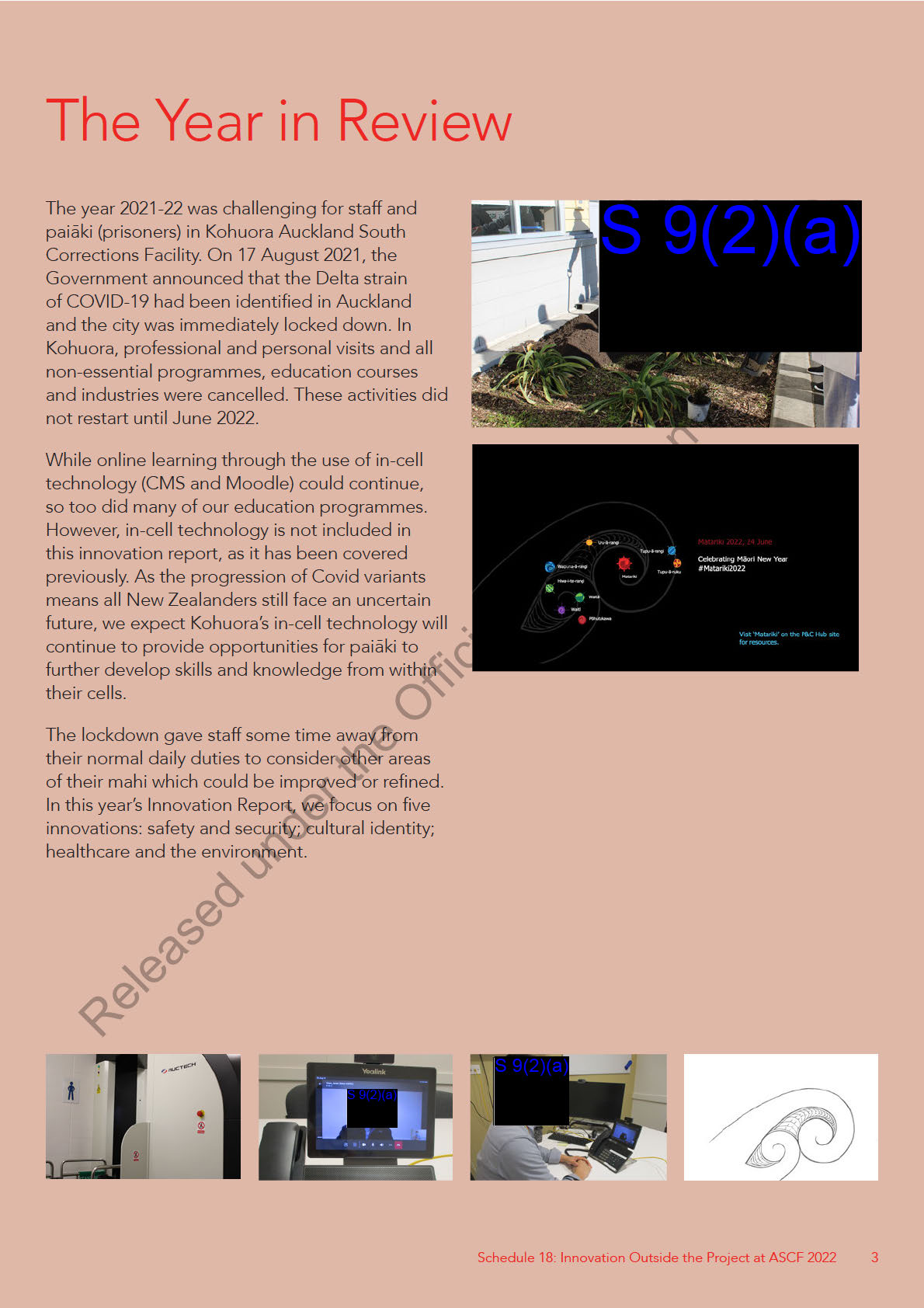
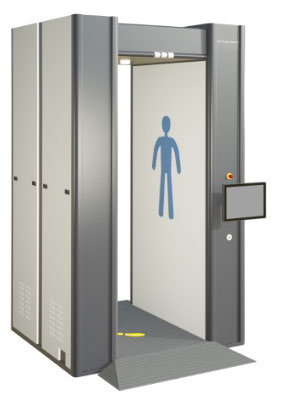
Full Body Imaging Technology
Serco New Zealand has a
statutory obligation to ensure
“ The Milliwave
the safe and humane treatment
of the people in our care. We
Scanner identifies
are also obliged to ensure
that there is
the safe and secure operation
of Kohuora Auckland South
something on a
Corrections Facility.
person’s body
Contraband entering Kohuora threatens
the safety and security of everyone in
and then Serco’s
Kohuora. The presence of contraband
may result in criminal convictions and can
additional security
also adversely affect the rehabilitation and
reintegration pathways of prisoners.
processes will take
The Full Body Imaging Technology in New
Zealand Prisons (FBIT) initiative introduces
effect.”
full body imaging technology in Kohuora.
Milliwave Scanner, used to screen all staff,
In October 2019, the Corrections Act 2004
contractors and visitors entering Kohuora
was amended to define the meaning of a
take effect. These may include using a
via the Gatehouse
scanner search and imaging technology
metal detection wand scan, requesting
search. This has enabled Serco to use fully
the person remains on site until the Police
body scanning technology, including x-ray
arrive, arranging a non-contact booth visit
The Milliwave Scanner emits high energy
technology.
only or banning them from future visits.
(non-ionising radiation) waves which travel
through clothing but not through the body.
Body inspection devices are designed to
X-Ray Body Scanner
quickly and easily detect prohibited items
The x-ray body scanner is located in the
All staff, visitors, contractors and volunteers
concealed on or inside the human body.
prisoner search area of the Visits Hall. It
who enter Kohuora will go through a
Using the latest in imaging technology
is a standalone device which does not
Milliwave Scanner, regardless of the reason
the scanners deliver clear, high resolution
exchange or send information to any other
for their visit. This replaces the former
images, reducing the need for physical “pat-
Serco or Corrections system. This device
process whereby visitors walk through a
down” screening or the need to strip search,
scans the whole body to detect contraband
metal detection ‘open tunnel’ and are
under the Official Information Act 1982
and maintaining personal space and dignity.
under clothing or in body cavities. It is
physically scanned using a metal detector
similar to a medical x-ray but at a much
wand.
Body scanners can identify metallic and
lower energy level (non-medical levels) and
non-metallic weapons, explosives, and
uses information from rays that bounce
The Milliwave Scanner:
narcotics.
from the body rather than pass through it.
• Takes a cartoon or silhouette-type image
which does not identify bones or bodily
The products meet the provisions within the
One of the primary benefits of the
detail (including no identifiable genitalia)
Corrections Act 2004 and health and safety
x-ray body scanner is that prisoners’
• Shows non-specific circles where an item
requirements for radiation dose exposure
sense of dignity and body autonomy is
is identified, whether that is some form
Released
limits. In line with Serco’s obligations
maintained while a comprehensive search
of contraband or an implanted medical
under the Privacy Act 2020, Privacy Impact
is conducted. We anticipate that the use
device such as a metal joint or pacemaker
Assessments have been published and
of ‘dry’ cells and requirement for staff
• Has a metal detector located in the base
shared with the Department of Corrections.
to monitor bodily excretions will be less
plate.
frequent. The management of prisoners in
Milliwave Scanner
dry cells is an ordeal for both prisoner and
The Milliwave Scanner identifies that there
Milliwave Scanner, used to screen all staff,
staff. The use of this technology will allow
is something on a person’s body and then
contractors and visitors entering Kohuora
staff to search prisoners more humanely
Serco’s additional security processes will
via the Gatehouse
and less intrusively than previously.
4
Schedule 18: Innovation Outside the Project at ASCF 2022
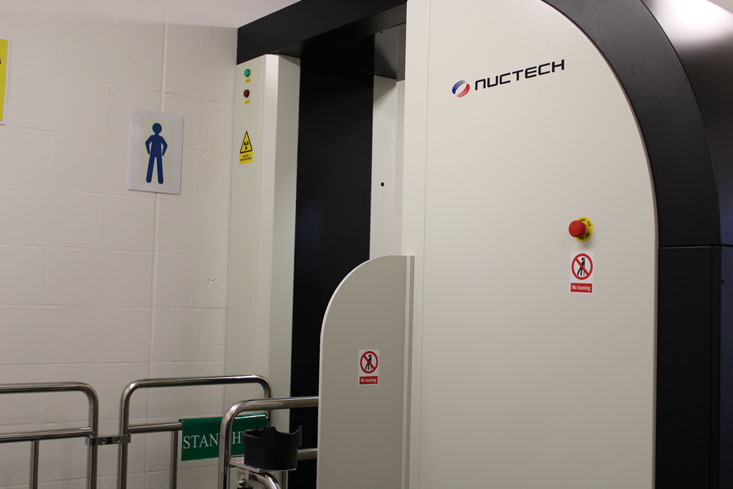

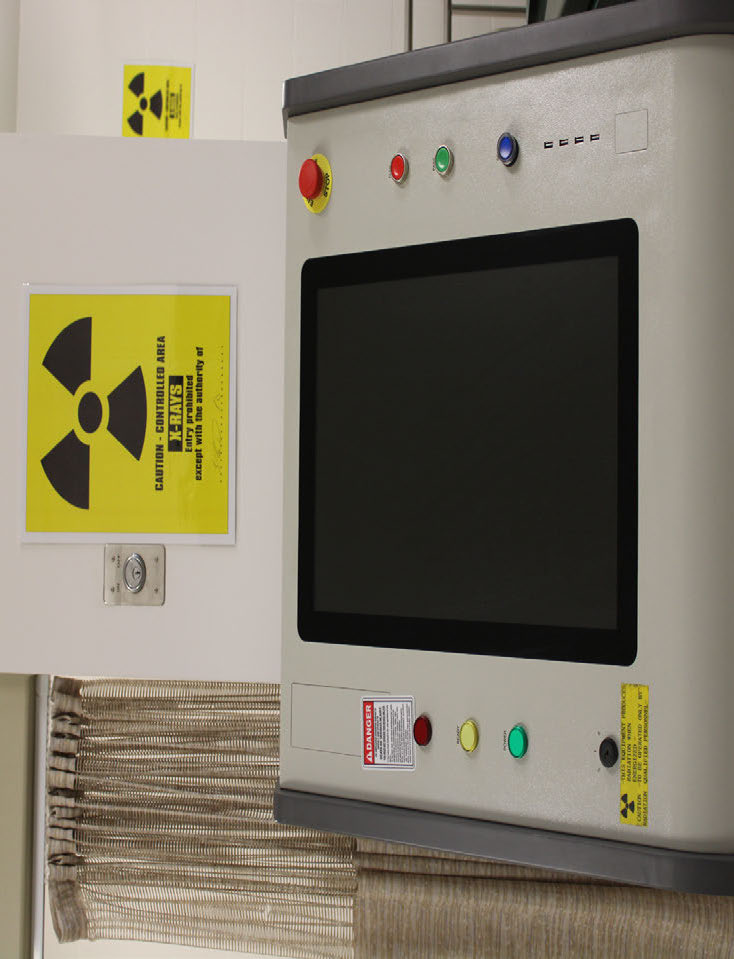
Deployment of the x-ray device provides
Serco with an x-ray image that could detect
contraband entering Kohuora. The image
itself is only held in the device for that day,
so staff operating the device are required
to complete an Incident Report, describing
their interpretation of what is seen in the
x-ray image when contraband is detected.
This interpretation serves as evidence for
any potential misconduct charge.
Prior to being scanned, a person’s PRN
and last name are entered. The person’s
fingerprint is then scanned, and a photo
taken to confirm identity. This is done to
fully confirm the person’s identity and
ensure that it is appropriate to scan the
person. Once this is complete, the person
stands on the x-ray device platform and is
scanned. Scanning takes approximately six
seconds.
under the Official Information Act 1982
Released
X-Ray Body Scanner
Schedule 18: Innovation Outside the Project at ASCF 2022
5
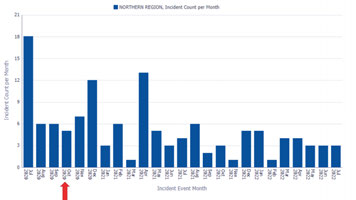
Hōkai Rangi: Cultural Wings
House Block 1 Wing 2
House Block 1 Wing 3
House Block 2 Wing 3
(voluntary segregation)
(voluntary segregation)
(mainstream)
Le Fale O’Le Anamua
Te Whare o Te Whaiora
Ngā Hau E Whā
Residence 3
Residence 6
Residence 9
(mainstream)
(mainstream)
(mainstream)
Te Ara Ki Pūwhakamua
To’a Pasifika
Te Whare Reo Motuhake
The establishment of cultural
tikanga in every aspect of daily life.
wings in House Blocks providing Te Whare o te Whaiora is not exclusively
“ What began as an
Māori: there are also Pasifika, Pākehā,
progression to cultural
Indian and one Kurdish paiāki in the wing.
Residences is aligned to the
The wing holds paiāki with a mixture
initiative to create
principles of Hōkai Rangi, which of classifications, from low to high. The
tikanga Māori
places a tikanga Māori lens over prerequisite for inclusion is a commitment
to tikanga Māori.
all its operations for Māori and
opportunities
non-Māori. Serco has partnered
Paiāki established a rūnanga and have been
with iwi to reduce reoffending
empowered to take greater responsibility
for voluntary
and create better outcomes for
for their conduct. While staff retain oversight
and management of incidents, they allow
Māori.
segregated paiāki
the rūnanga to manage minor infractions
within the wing, such as a paiāki damaging
Te Whare o Te Whaiora
in one wing has
their personal property or bad language.
We initially took an innovative approach
Staff continue to manage all serious
in one hard-to-manage wing within a
issues. Te Whare o te Whaiora initiated
quickly developed
House Block of voluntary segregation
a reconnection to strong cultural values
paiāki (people in our care). As Kohuora
promoting positive attitudes, a greater
into a site-wide
is a campus style prison, this cohort of
sense of wellbeing and whanaungatanga.
paiāki have significantly restricted ability to
integrated
take part in programmes, employment or
Unlike in other wings, paiāki are unlocked
education opportunities.
all day, including Tuesday afternoons,
approach.”
under the Official Information Act 1982
when prisoners are locked to facilitate staff
Statistically, Pākehā programmes have
training. The wing is unlocked an hour
not had great impact on Māori recidivism.
before other locations and the last to be
Approximately 400 paiāki in Kohuora are
secured. Cell doors remain open all day.
waitlisted for programmes not delivered at
Many of the men also have regular jobs in
this site. Not having completed designated
the kitchen, canteen and recycling and run
Pākehā programmes is frequently an
a barber shop in the House Block foyer.
obstacle for the progression of many Māori
Released
on their individual reintegration pathways.
What began as an initiative to create
The challenge was to provide an alternative tikanga Māori opportunities for voluntary
rehabilitation pathway ‘by Maori for Maori’,
segregated paiāki in one wing has quickly
but with universal principles which are also
developed into a site-wide integrated
relevant and suitable for paiāki from other
approach. The men were keen to share
Te Whare o Te Whaiora Incidents
cultures.
what they learned with men from other
wings in the House Block. Men from Te
Ngā Hau E Whā
The innovation began with the
Whare o te Whaiora worked in Wing 2 each There are currently 52 members in the
establishment of a Kaupapa Māori Wing, Te day, running a wananga, teaching kapa
wing, ranging from high to minimum
Whare o te Whaiora, which upholds Māori
haka and karakia.
security. All prospective members are
6
Schedule 18: Innovation Outside the Project at ASCF 2022
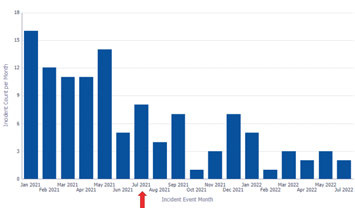
provided a copy of the contract and take
sharing Pasifika cultural experiences. Many
part in a short hui with the rūnanga to
Pasifika men have learned cultural values
“ All the cultural
decide whether the wing is right for them.
from a young age and being part of a
Pasifika environment is an opportunity to
Residence houses
The majority in the wing are patched/
reawaken and teach other men through
associate members from nine different
how to behave and share Pasifika stories
are resourced
gangs, but it is a requirement that they
through writing, song and dance.
live together in harmony and recognise
each other through whakapapa over gang
Custodial and cultural teams work together
with stationery,
affiliation. In the past six months, there
to ensure that learning is free-flowing and
have been only two misconducts in this
constant, creating an atmosphere for the men
books, teaching
high security unit and it remains one of the
to flourish. Pasifika staff assist in providing
best performing units in terms of incident
tools and equipment for positive learning. Le
tools and music
statistics on site. For each month that
Fale O’Le Anamua also provides a pathway
no misconducts are recorded, the wing
for the men in which positive behaviour is
to enable them
receives a BBQ on a Saturday.
rewarded through progression from the
House Block to the To’a Pasifika Residence.
to put the cultural
Eight men in the unit have stepped up
as rūnanga members and meet with the
Cultural Residences
knowledge they
Hōkai Rangi Kaihaapai and the Operations
To enter any of the cultural houses in
Manager every fortnight to discuss their
Residence, men must have spent at least
progress and resources required. Six men
six months in a House Block cultural wing
have learned into
in the wing have volunteered as Kaiako.
and have had no behavioural incidents,
They receive support from Pūwhakamua
active misconducts or charges before a
practice.”
to accelerate their Te Reo Māori learning
court in the previous six months. All new
every week and formulate a lesson plan to
members must have Minimum or Low
teach others in the wing.
security classification and be within six
months of their Parole Eligibility Date or
Le Fale O'Le Anamua Complaints
have had at least one parole hearing. They
60
all have a two-week trial to allow them to
50
settle in and show full commitment to the
40
2020
kaupapa of the Residence.
30
2021
20
2022
They must provide a negative drug test
10
and agree to a frequent drug testing
0
Jan Feb Mar Apr May Jun Jul Aug Sep Oct Nov Dec
programme. Gambling, gang activity and
gang signs are not welcome.
Le Fale O’le Anamua Complaints
Ngā Hau e Whā Incidents
Te Ara Ki Pūwhakamua differs from To’a
Pasifika and Te Whare Reo Motuhake in
Pūwhakamua come to Kohuora every
that all prisoners in Te Ara Ki Pūwhakamua
Friday to hold a four-hour tikanga wānanga
have a release plan to Pūwhakamua in the
with Ngā Hau E Whā. Staff are always
community. Facilitators from Pūwhakamua
welcome to attend these wānanga.
offer wānanga twice a week.
under the Official Information Act 1982
Le Fale O’Le Anamua
All the cultural Residence houses are
Although relatively new to Kohuora,
resourced with stationery, books, teaching
the Pasifika focus wings have made an
tools and music to enable them to put the
immediate positive impact. There are
cultural knowledge they have learned into
two Pasifika wings: Le Fale O’Le Anamua
practice.
in House Block 1 and To’a Pasifika in
Residences. Both areas aim to provide
This progression from House Block to
a safe space for all men who live there,
Residence means the men will not lose
Released
whether they are of Pasifika heritage or not,
the cultural knowledge they have recently
to learn together and align the values our
learnt. In the Residence they can reinforce
Pasifika people hold dear and apply them
and build on their learning by applying it
to everyday living situations or moments
in a place where reintegration is practised
that may trigger them into reoffending.
every day. Positive reinforcement through
Māori and Pasifika cultural practices is
Values of humility, honesty, respect and
driving change in our men at a faster rate
leadership through service are encouraged
than in other accommodation areas.
and practised daily. The men have
developed a sense of community through
Schedule 18: Innovation Outside the Project at ASCF 2022
7
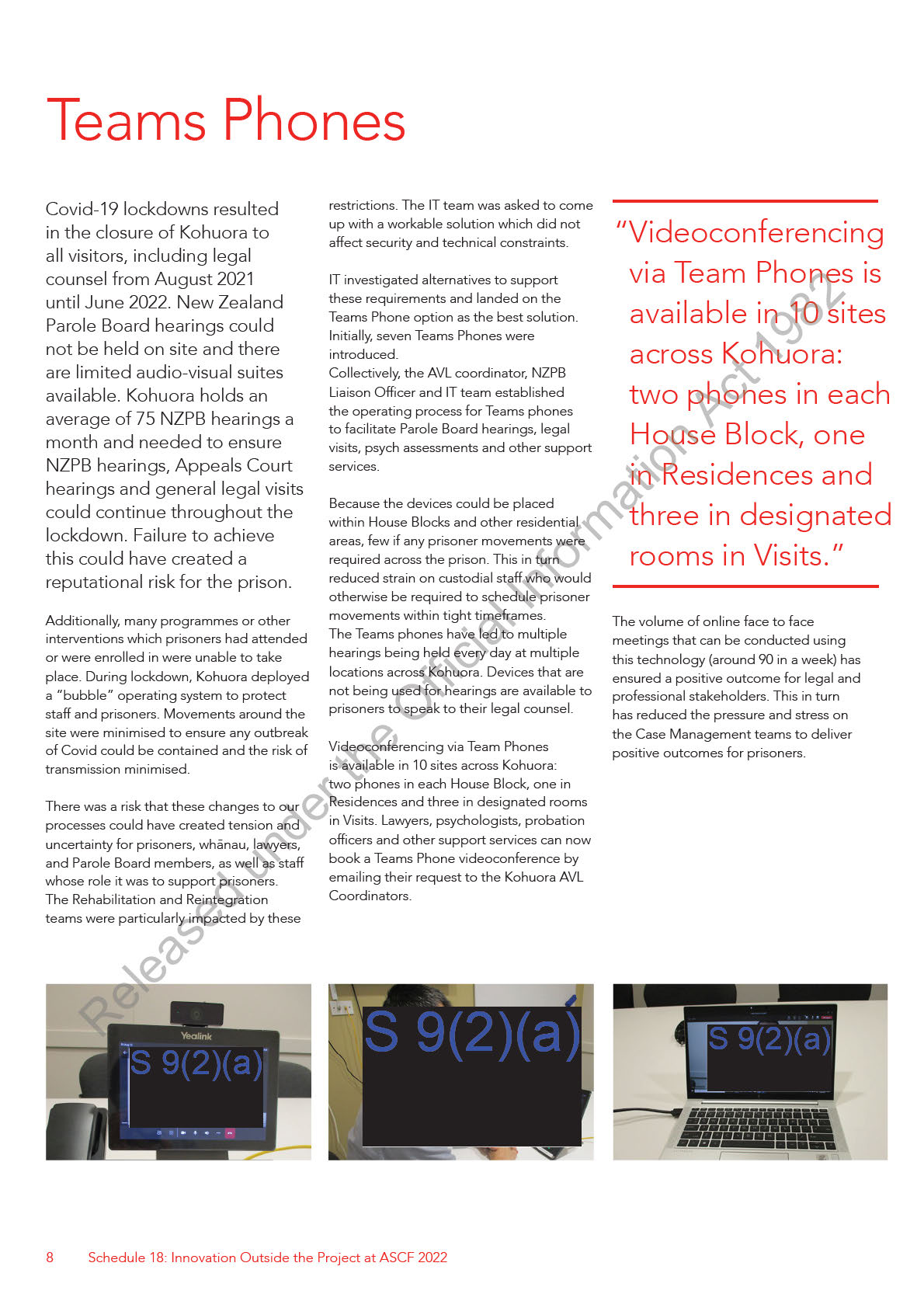
Cornerstone
The Kohuora Health Services
and providing evidence on the use of
rolled out to staff, feedback reviewed,
team undertook a large-scale
up-to-date population ethnicity data to
amendments made as needed and
respond to health equity requirements.
then finalised. Historic ACC claims were
review of the health service
reviewed and retrospectively claimed.
delivery, specifically with the
The health team has developed and started
main aims of:
to embed a more equitable and Kaupapa
To support a culture which focuses on
• Improving the current model
Māori/Te Whare Tapa Whā-based health
continuous improvement, efficiency
practice (physical, psychological, family and
and is patient-centred, the health staff
and services to be more
spiritual health). Staff were trained in Te
demonstrated the value in being effectively
productive
Tiriti o Waitangi, He Tirohanga Māori and
engaged to improve the quality and safety
• Ensuring contractual
unconscious bias, laying the foundations
of the healthcare services delivered in
obligations, including reducing for supporting an inclusive and culturally
Kohuora.
safe environment and patient experience
reoffending, continue to be
including whānau.
Areas reviewed by the team included
met
process mapping the patient journey,
• Developing and future
CQI
staff interviews, patient experience survey,
proofing services in line with
CQI accreditation acknowledges evidence
workshops, wait list analysis, complaints,
that health staff can question and review
incidents, the current finances of the
best practice health service
their day-to-day work, empowering them
current services (including contracted
development.
to undertake quality improvement cycles
services eg dental, physio, optometry)
to provide better outcomes for staff
review of the current staffing and operating
The team was due for renewal of the
and/or patients. Following the review of
model. The health team also looked at
Cornerstone Foundation status, the
demographics, health needs and prisoner
the current demographics and specific
RNZCGP quality assurance programme.
ethnicities, several areas of need were
health needs of prisoners compared to the
Following the recent review, the Health
identified. These included an increase in
previous demographics and health needs.
Team collectively agreed to undertake
the number of Māori men, an increase in
two additional modules on top of the
prisoners aged over 40 as well as prisoners
The Health team also evidenced other
standard renewal process. This required the held in Kohuora for longer than they were
improvements. These included a Quality
team to evidence their delivery of a more
previously.
Board, displayed in the Health Centre
culturally appropriate health care service in
showing patient feedback and how the
Kohuora, supporting the needs of prisoners The Health team’s aim was to support
team is tracking against health targets
in our care, implementing continuous
better health outcomes for this cohort and
and patient feedback. A values and
quality improvement methodology and
others. Additionally, through undertaking
management board shows the health
challenging staff to develop new strategies
reviews and gap analyses, the team
team’s performance, for example, health
to benefit staff and prisoners.
identified several smaller CQI initiatives
documentation from electronic records,
that supported the above larger piece of
ethnicity, and cost of clinicians undertaking
under the Official Information Act 1982
The Kohuora health team has achieved
work but also allowed them to test their
ACC clinical assessments against ACC
accreditation in two additional core
processes.
financial reimbursement.
Cornerstone modules, Equity and
Continuous Quality Improvement (CQI).
One example identified for review was how
Accreditation in these modules evidences
clinical time was used: this led the team to
the measures the health team have
Equity
look at clinicians undertaking numerous
undertaken to provide more support in
Equity accreditation acknowledges
ACC clinical treatments. Due to process
addressing the increasing Māori population
evidence that the health team has built
failings, no ACC claims were received
and associated health complexities,
on its foundations for supporting a more
by Kohuora for the treatment provided.
overrepresented within the prison
Released
inclusive and culturally safe environment
The team reviewed the full ACC process,
population. The Health team continues
and patient experience, including whānau.
including lodging, claiming and invoicing,
its work in further developing a modern,
To achieve this, staff required a deeper
which had resulted in the lack of financial
culturally appropriate model of care
understanding of health equity and Māori
reimbursement.
suitable for the health needs of the people
health. For example, some of the areas
in our care.
identified that needed addressing were,
The ACC clinical processes began with a
culturally appropriate training, updating all
Fishbone analysis as a root cause analysis
health succession profiles to include the
tool, followed by PDCA cycles including
team’s commitment to Te Tiriti o Waitangi,
developing a training tool. This was
Schedule 18: Innovation Outside the Project at ASCF 2022
9
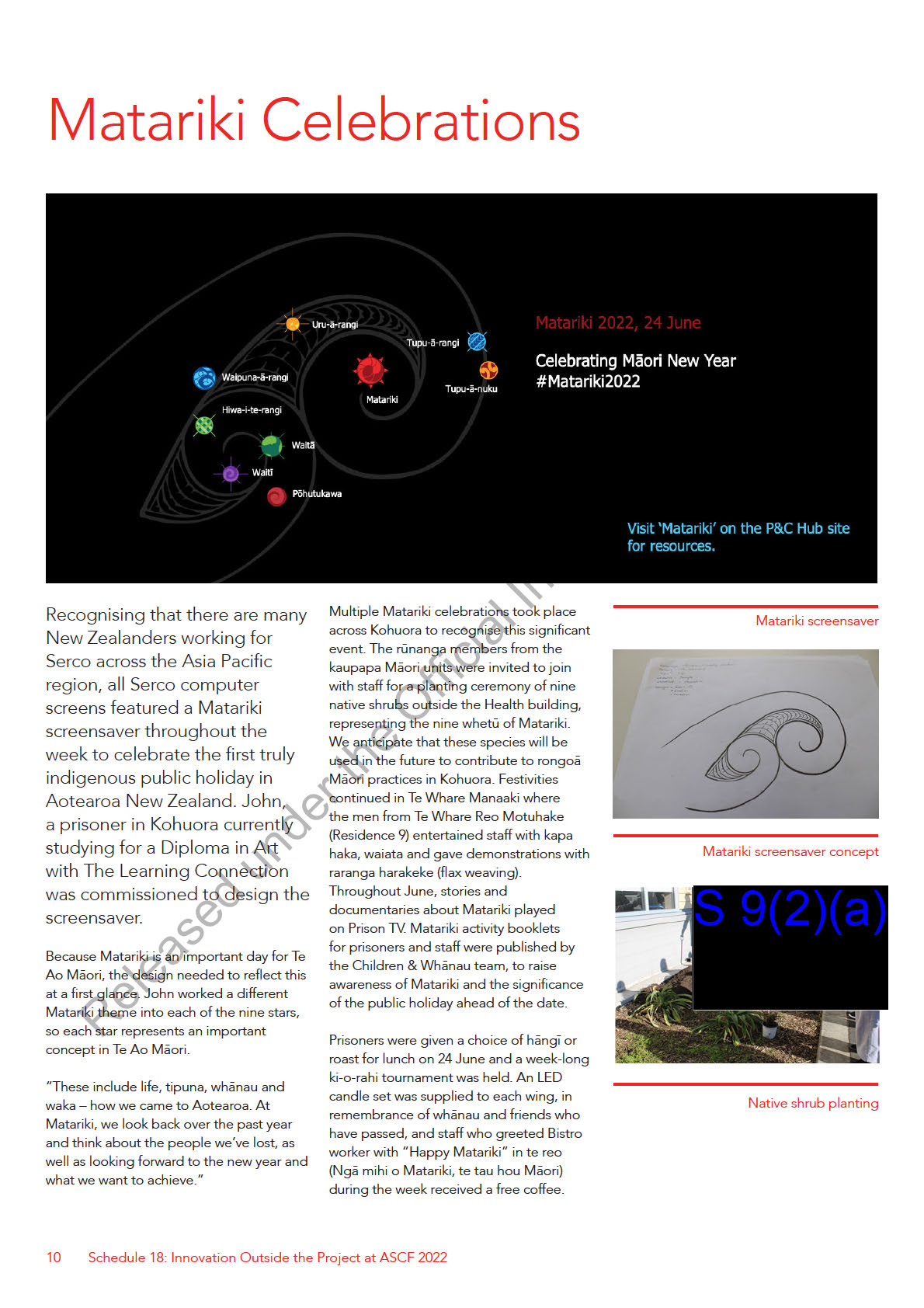
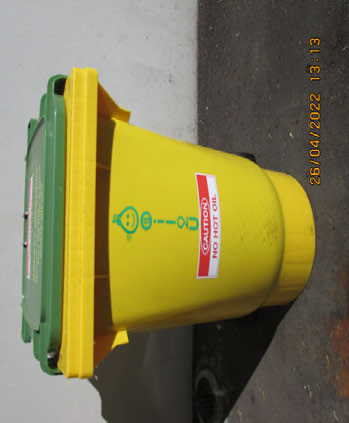

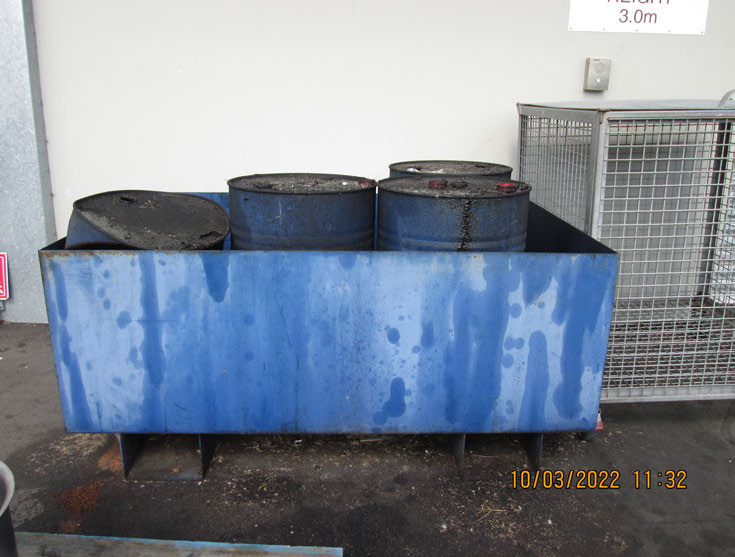
Cleaner Greener Oil Supply
A total overhaul in the way waste
cooking oil is removed from the
Kohuora kitchen has resulted in a
cleaner, safer and greener service.
The Safety Services Manager had expressed
concerns that the former contractor who
removed waste cooking oil from the prison’s
kitchen did not have a documented Safe
Work plan and declined to participate in
a joint risk assessment of his deliveries to
Kohuora. He also did not hold a spill kit in his
truck, as he had never seen the need for one.
The oil drums were old and had never been
cleaned, as the “before” photo clearly shows.
The new contractor uses wheelie bins with
lockable lids, which are cleaned after each
service. The Safety Services Manager and
the contractor jointly developed a risk
assessment, and a fully stocked spill kit has
been provided to the kitchen.
In addition to the more efficient and safer
Before
methodology with the new contractor, Oil2U
not only removes the kitchen’s waste cooking
oil, but is also our supplier of fresh canola oil
This is a closed loop system where fresh oil is
delivered and waste oil removed on the same
day, with the whole process taking roughly
half an hour. This has lowered our carbon
emissions, as we now contract just one
supplier for both activities.
Oil2U produces chemical free canola oil
under the Official Information Act 1982
from seeds grown in Western Australia. The
process is a unique cold pressed system that
extracts clean and pure oil from the seed.
All cooking oil is refined, bleached and
deodorised: the steps that transforms crude
oil into ready to eat cooking oil the supplier
refines their oil through steam, heat and
vacuum and no harmful chemicals are added
After
Released
to the process.
It’s also better for the environment, as Oil2U
ensures there is no waste: the used cooking
oil is converted into a sustainable supplement
and sent to farmers for stock feed.
Certification for Hazard Analysis Critical
Control Point (HAACP), Halal, Kosher, GMO
and Vegan is available from the supplier on
request.
Schedule 18: Innovation Outside the Project at ASCF 2022
11
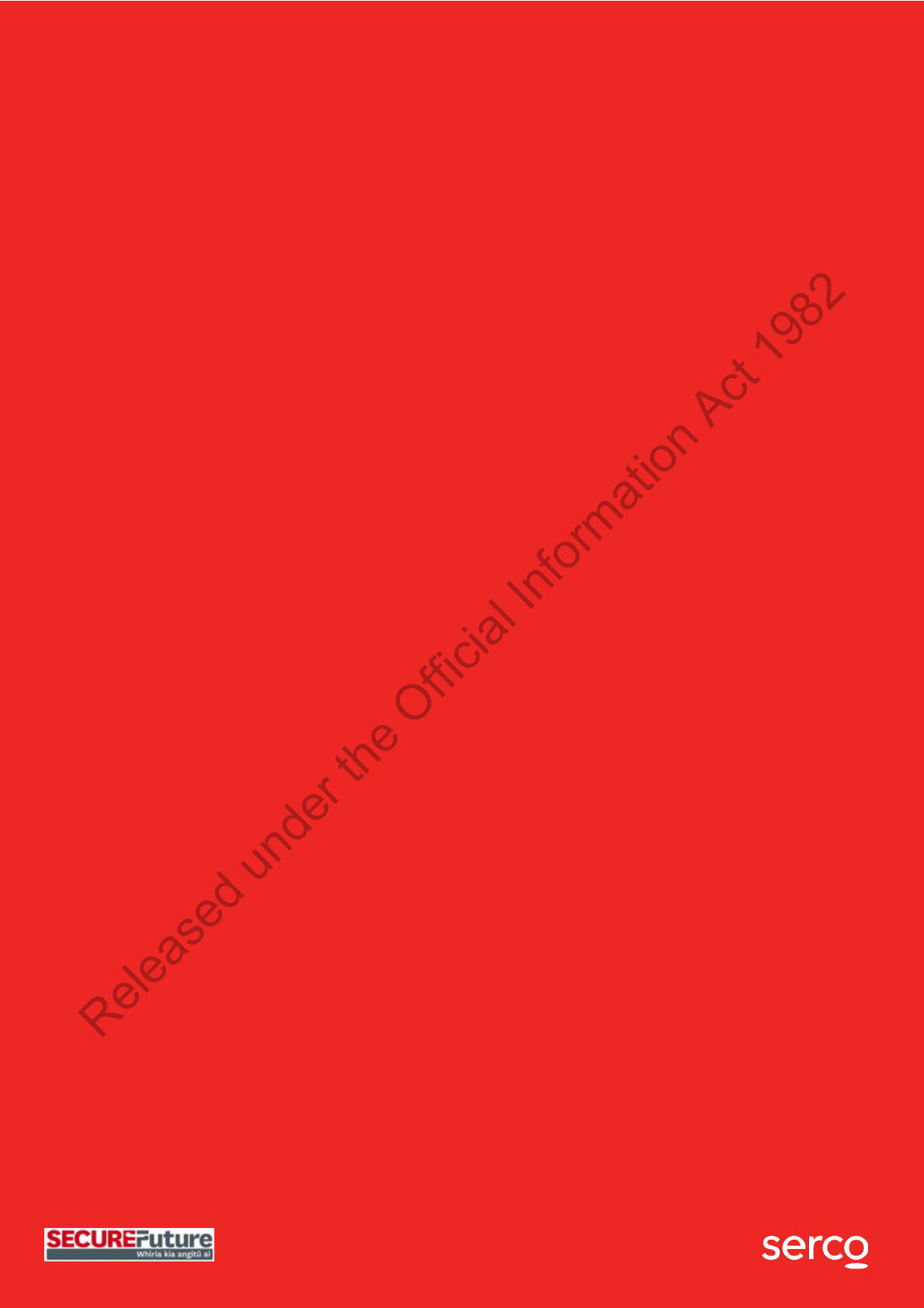
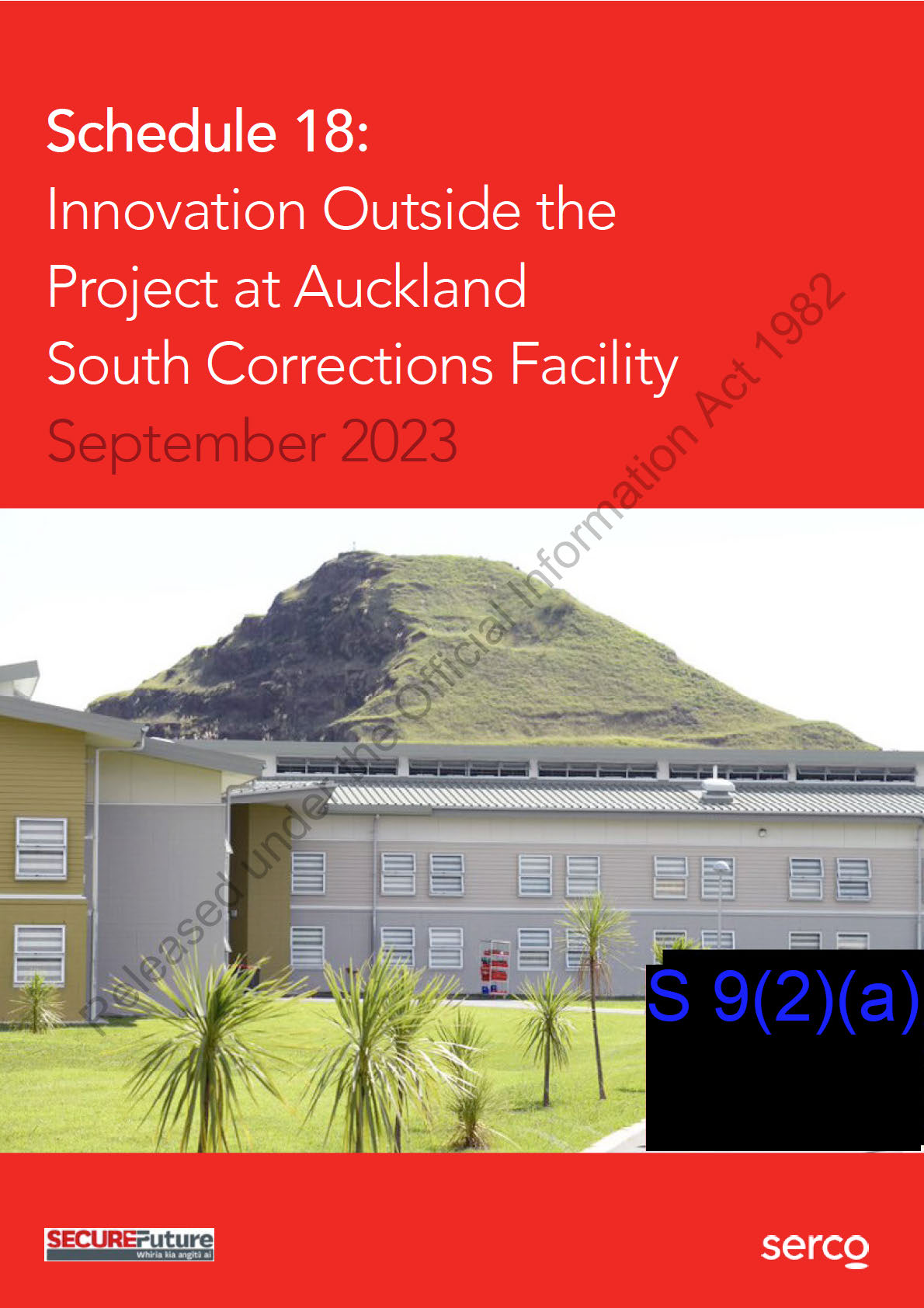
Contents
1.
The Year in Review
3
2.
ACR Training
4
3.
C-Pen Reader
5
4.
Emergency Consult
6
5. Environment
7
6.
Psychotherapy Students and Intern Psychologists
8
7.
Spotless Innovations
9
8.
Te Whare Manaakitanga
10
under the Official Information Act 1982
Released
2
Schedule 18: Innovation Outside the Project at ASCF 2023
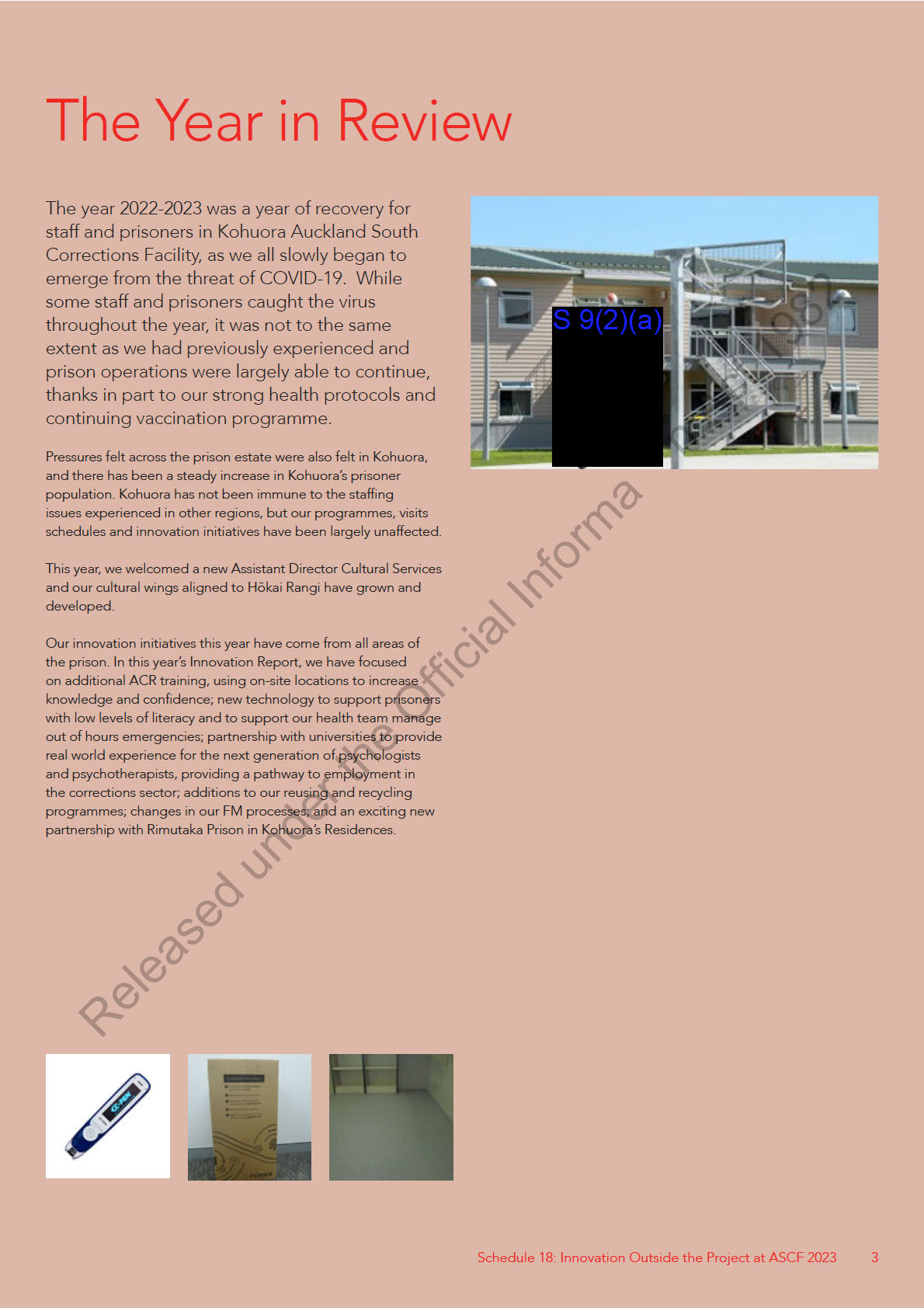
ACR Training
Following a review of ACR
Practical exercises
performance in Kohuora
The team is divided into two groups, each
“ This is a relatively
with a section leader. Drills are conducted,
Auckland South Corrections
with team members rotating roles to
Facility, Serco has determined
ensure everyone gets hands-on experience.
recent innovation
that while the annual refresher
Different team formation drills, such as
in Kohuora, but
training is comprehensive,
skirmish or line formation, are practised. At
each phase, instructors provide immediate
additional refresher training will
feedback and correct actions to improve
feedback from the
ensure staff keep up to date
performance.
with best practice. To maintain
ACR team has been
the highest standards, monthly
Scenario integration
A simulated prison incident is set up in the
on-site ACR team training has
overwhelmingly
sports hall or industry workshop, with at
recently been introduced on
least three staff role-playing as aggressive
positive to date.”
site, allowing the team the
prisoners. The team is required to move
opportunity to use areas within
through the location while encountering
obstacles, neutralise the incident, secure
Kohuora, such as the gym (set
the area and arrest the prisoners. They are
up in the style of a wing) and
tested and assessed on their ability to apply
Industry workshops to simulate
appropriate de-escalation techniques,
potential scenarios. In addition
non-lethal force and physical control
holds, while also adapting to changing
to physical training to maintain
circumstances. Instructors evaluate their
standards and familiarity with
communication, co-ordination, decision-
appropriate techniques, Serco’s
making and overall performance.
training regime incorporates
Debrief
desktop scenarios, to enhance
Potentially the most important aspect of
theory and planning skills.
any training scenario, the debrief is an open
forum for all participants and instructors to
Each training session is divided into three
provide constructive feedback and raise
phases:
questions or concerns. The team discuss
• Entrance method
the strengths and weaknesses observed
• Team formation
and experienced during each phase of the
• Arrest and recovery.
training and scenario integration. Team
under the Official Information Act 1982
members are encouraged to share their
Briefing
experiences and insights, and areas for
In each stage of the training, the team
improvement can be identified.
is briefed on the specific scenario and
exercise objectives. These include the
Future activities
rationale behind certain methods in
This is a relatively recent innovation in
different situations, the importance of
Kohuora, but feedback from the ACR team
gaining control through integrated group
has been overwhelmingly positive to date.
actions, the correct use of equipment and
We anticipate that as we conduct further
Released
ensuring the correct protocols are followed
training sessions over the next four to six
to maintain safety and security of everyone
months, we will be better placed to provide
involved. Team members are encouraged
more meaningful insights to Corrections on
to discuss previous simulated or real ACR
the impact of this initiative.
experiences. Where applicable, instructors
demonstrate the preferred methods.
4
Schedule 18: Innovation Outside the Project at ASCF 2023
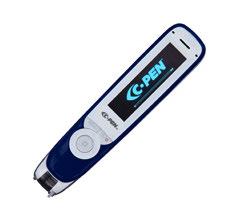
C-Pen Reader
While there is no authoritative
in workshops, and increase confidence
study on levels of dyslexia or other
in learning, as an important part of the
“ Prisoners using
difficulties associated with reading and
rehabilitation process.
comprehension, the general agreement in
prison-based studies is a rate of about 30%
Prisoners using scanning pens were able
scanning pens
dyslexia, with rates of serious deficits in
to overcome the barriers created due to
literacy and numeracy reaching as high as
illiteracy or poor reading skills, enabling
were able to
60%. No-one, however, denies that levels of them to successfully gain qualifications or
dyslexia among prisoners is very high and
strategies to access the written word.
overcome
that the negative impact goes much further
than the challenges of reading and writing.
Outcomes
the barriers
Education staff demonstrated the use
Serco has focused on an innovative new
of Reader-Pens to learners in courses,
created due to
product from British company Scanning
acknowledging the positivity of the
Pens. The Reader-Pen Secure scans text
learner’s relationship when accepting the
illiteracy or poor
and reads it aloud or via headphones,
introduction of assistive technology.
facilitating the user’s desire to read
independently. The device helps users
Tutors observed an increase and
reading skills,
develop their literacy skills and reading
acknowledgment from learners
independence.
experiencing reading difficulties.
enabling them
Additionally, prisoners wished to be
Although versions of the device have
supported by their peer mentors and the
to successfully
been available for a few years, with an
Reader-Pens. Courses are often considered
Exam-Reader version officially approved
inaccessible due to the assumption of little
gain qualifications
for use in exams in the UK since 2013, it
or no reading. However, courses involve
is only much more recently that a version
workbooks/worksheets which must be
or strategies to
has been developed suitable for secure
completed to enable a qualification to be
environments.
gained.
access the written
The Secure version of the device works in
Tutors reported a reduction in time
exactly the same way as the mainstream
required during lessons, to support
word.”
pen but does not have any storage
reading, therefore allowing them to deliver
capacity. It has also been designed so that
each section of the course faster. Reading
it cannot “back charge” illegal mobile
support can be achieved independently
phones or other devices. It has also been
by the prisoners using the Reader-Pen to
tested and confirmed that it does not
decode the text.
under the Official Information Act 1982
present any fire risk, which could potentially
be fatal in a cell environment.
Noise cancelling headphones means that
people in noisy prison environments still
Serco has acquired two pens for Kohuora
find it easy to concentrate and improve
Auckland South Corrections Facility,
their reading skills. While the Reader-
following a trial in SQCC, Australia. An
Pen is available in a number of different
independent researcher undertook a series
languages, these do not yet include
of studies exploring issues affecting the
Pasifika languages which would best meet
educational outcomes of learners in prison.
the needs of the New Zealand prison
Released
environment.
The findings indicated the positive impact
of Scanning Pen technology to support
the implementation of learning, improve
C-Pen Reader
educational outcomes and independence.
They support the importance of gaining
transferable skills, such as those taught
Schedule 18: Innovation Outside the Project at ASCF 2023
5
Emergency Consult
Serco’s culture is based on
We are committed to improving the
four values – Trust, Care,
health of prisoners in our care and of
“ Serco considers
their whānau. This involves working
Innovation, Pride – that shape
collaboratively with the community to
our individual behaviours and
ensure prisoners are supported throughout
this innovation an
the way the company behaves.
their time at ASCF and in their transition
important addition
We hold ourselves and others
back to their community.
accountable for our values every Within the current health model, when
to its healthcare
day. They describe how our
an afterhours nurse is unsure of the best
behaviours bring Serco’s values
treatment for a patient who has presented
practice, as it
to life.
with moderate illness or injury but which
may be more serious, an external hospital
provides an
escort is required. This is costly and a drain
Trust – we work hard to earn trust and
on both the prison resources and the public
respect. We deliver on our promises, are
enhanced level
hospital system.
open, straightforward and honest, do the
right thing, and take personal responsibility
Serco is introducing Emergency Consult to
of care to our
for getting things done.
provide video on demand consultations,
provided by emergency medicine
patients.”
Care – we care deeply about the services
veterans, for the people in our care.
we provide, the communities we serve, and
Emergency Consult was established in
we look after each other. We work together
2019 and provides 24-hour urgent care
to deliver high-quality public services, often
An experienced Registered Nurse or a
remotely. Emergency Consult has a team
of great importance to the communities we
reputable emergency doctor (FACEM)
of approximately 30 doctors and the same
serve. We aim to make a positive difference
will answer. Essential details may be first
number of Registered Nurses.
to people’s lives.
collected by a triage nurse. The ASCF
nurse and patient will be present during
This service will allow a nurse in Kohuora to
Innovation – we continuously improve our
this call.
set up a consultation for a patient who, for
ways of working, and try new ideas, big
example, has chest or abdominal pain, or
and small. We share our knowledge and
All patient information is stored in the S 6(c)
who has a minor injury, or who has a chronic
experience and embrace change, knowing
medical condition that has deteriorated. An
that if we don’t provide innovation and
appropriate treatment plan can be devised
value for money to our customers, our
and decisions made about where and how
competitors will.
that care should be delivered, and whether
they need immediate hospital care.
Pride – We want to be proud of what
S 6(c)
under the Official Information Act 1982
we do. We know that the work we do is
ASCF is not replacing the onsite routine
important, and we take pride in doing it
GP visits that maintain the day to day
well. We value energy and enthusiasm, skill
care for patients. This service will be used
and experience, and an ability to make
for afterhours where a patient has an
hard work fun. We contribute both as
immediate need but the nurse is unsure
individuals and as part of a team.
whether hospital transport is required.
Serco considers this innovation an
We continue to develop and maintain
important addition to its healthcare
When ASCF has a patient requiring GP
Released
a culture promoting patient safety
practice, as it provides an enhanced level
consultation but a GP is not onsite, or
and innovation which is supported by
of care to our patients. It will reduce the
nursing staff are considering transporting
appropriate systems, processes, and
strain on the afterhours nursing team, who
to hospital, a consultation will be booked
structures. We continue to encourage
can rely on the support of experienced
with Emergency Consult. The video call
staff to learn and develop as much as
emergency health practitioners. It will
is automatically directed to the relevant
possible. Staff are actively involved in the
reduce escorts to hospital from the facility.
clinical team who are online and waiting.
development of new practices, systems,
and processes.
6
Schedule 18: Innovation Outside the Project at ASCF 2023

Psychotherapy Students and
Intern Psychologists
Aotearoa is experiencing a
providing criminogenic treatment, safety
support for prisoners’ mental health
shortage of mental health
plans, and referrals.
concerns, such as anxiety or depression,
which can help to address potential
practitioners, and as such
The treatment waitlist is used to allocate
treatment barriers. Their work provides an
they are considered part of
individual criminogenic treatment to the
additional mental health resource for the
our national long-term skills
psychology interns. They treat the prisoners’
onsite health team, noting that not all mental
shortage. The New Zealand
rehabilitative needs, such as general, violent,
health nurses are trained therapists.
and sexual offending (or combinations),
Psychological Society recently
AOD, and/or associated mental health
Psychotherapy students support prisoners
released a statement, stating
conditions.
to discuss their mental health concerns in
that Aotearoa required an
a safe environment, to improve prisoners’
additional 1000 psychologists.
While Intern psychologists do not write NZPB self-awareness and understanding of their
reports, their risk assessments and treatment
mental health. They work with the prisoners
information may be included in reports.
to improve their motivation and escalate
This financial year, the PS&I team has been
concerns for any who may have suicidal
required to write over 300 reports to the
Feedback from university academic staff:
ideations.
New Zealand Parole Board, which has
1.Thank you again for hosting us last week.
significantly impacted the team’s ability to
We very much appreciated meeting you
Through their training, psychotherapy
conduct interventions with the prisoners who
kanohi-ki te -kanohi, and the genuinely
students focus on how to be effective
require these. The team has expanded the
hopeful and progressive attitude of the staff
treatment agents and have received high
intern psychologist numbers to manage the
was palpable. [The students] are well placed
praise from the prisoners they have worked
increased demand for these services.
to experience excellent training and growth
with. Over time, therapy can allow prisoners
at Kohuora, and I look forward to hearing
to better manage their thoughts, emotions
In 2022, the Psychology Services &
how they respond to their learning through
and behaviour.
Interventions department hosted two intern
their contribution to the service.
psychologists and this year we have hosted
Case Managers or custodial staff can refer
four. Our expectation is that next year
2. What wonderful feedback and what an
prisoners who have mental health needs
we will host between seven and 10 intern
incredible learning opportunity our students
to the health team, who in turn triage them
psychologists.
are having. Thank you so much for letting
and refer them to psychotherapy students.
me know how things are going. Regarding
Here they are furthre triaged for risk, by one
Intern Psychologists are in their final year
internships, I will get onto emailing the
of the intern psychologists, who will assess
of study to complete the requirements for
students this week to ask them to apply as
each prisoner’s needs before considering
a Master of Psychology degree and will be
under the Official Information Act 1982
soon as possible. I am hopeful that we will
whether they are suitable to be allocated to a
ready for registration at the end of their
have some students to interview with you!
psychotherapy student.
internship. Training psychologists specifically
in forensic work creates a realistic pathway
The PS&I team have been working hard
Intern psychologists and psychotherapy
for students interested in working in a New
on continuous improvement of our various
students are encouraged to inform and
Zealand prison at the end of their training.
placement programmes. The net result
consult with the larger multi-disciplinary
is that Kohuora is currently AUT’s biggest
team, i.e., supervisor, PS&I team, case
This year’s cohort are from Te Herenga
single placement agent for psychotherapy
management, programmes facilitators, and
Victoria University of Wellington and AUT.
students; we have received more intern
custodial staff. The purpose is to help them
Released
They have individual clinical supervision
applications for 2024 than ever before; and
understand their clients’ needs, progress,
each week with Kohuora’s Senior Clinical
have grown our tertiary stakeholder footprint
specific barriers, and mitigate potential risk.
Psychologist and additional supervision from
to five universities.
their respective universities.
Feedback from university academic staff:
Kohuora has held an association with the
The placement is clearly a powerful place
They support prisoners in Kohuora by
New Zealand Psychotherapy Board for
for the psychotherapy students; all of whom
providing Short Motivational Programmes,
three years. Over the past year, Kohuora has
clearly appreciated the opportunity of being
conducting prison assessments (holistically
hosted six psychotherapy students, who are
placed at Kohuora. I think you offer the
assessing risk, as well as cultural, whānau,
in their first and second years of a Master’s
students the holding and guidance they
medical, and mental health needs), and also
degree. They provide psychotherapeutic
need.
8
Schedule 18: Innovation Outside the Project at ASCF 2023
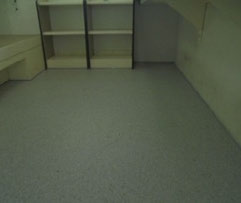
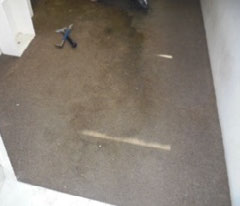
Spotless Innovations
Vinyl Replacement
The decision has been made to replace
carpet in House Block 3 cells when the
carpet lifecycle ends. House Block 3 is the
only carpeted House Block. This was initially
introduced as a component of the prisoner
progression model. Vinyl has been identified
as being more fit for purpose, following
multiple biohazard cleaning events required
in the House Block.
There are also significant costs associated
with carpet cleaning. House Block 3
biohazard cleaning costs have been
S 9(2)(b)(ii)
upwards per event. While vinyl will still
Before
After
require cleaning, the cleaning time and
impact will likely be reduced.
Spotless anticipates that this will not
only result in significant savings on future
biohazard cleaning requirements, but will
also create a healthier environment for the
prisoners in the House Block, with minimal
opportunities for spore growth through
mould.
Flat face surface mount plugs in the Main
Kitchen
The idea of surface mount plugs was initially
suggested by the Catering Manager. This
was made following multiple failures on the
existing plug type. The existing type were
constantly being damaged by the trays and
items being slid on the tables.
Damage to the plugs can cause a major
under the Official Information Act 1982
health and safety issue, as anyone working
in the kitchen could be exposed to electric
shock. Moving to a flat face surface
minimises this potential. Replacing power
S 9(2)(b)(ii)
sed
points costs over
per replacement.
While the flat face surface mount plugs
can still be damaged, we anticipate
fewer sockets will need to be repaired as
frequently as the old models.
Rele
This work was successfully trialled in the
bakery section of the Main Kitchen, with new
isolation points created above the benches.
All future breakages will be replaced with flat
surface plugs.
Schedule 18: Innovation Outside the Project at ASCF 2023
9
